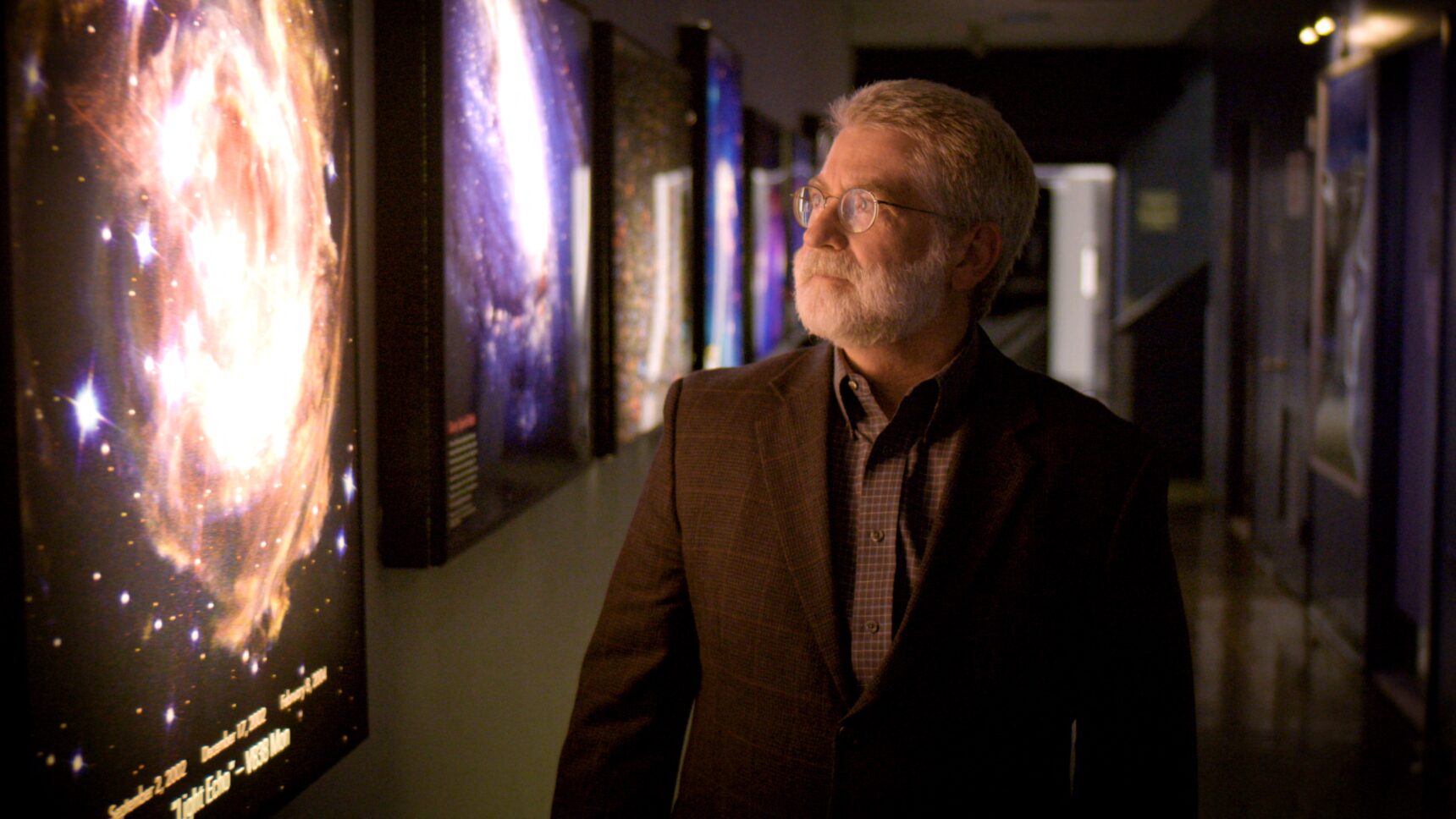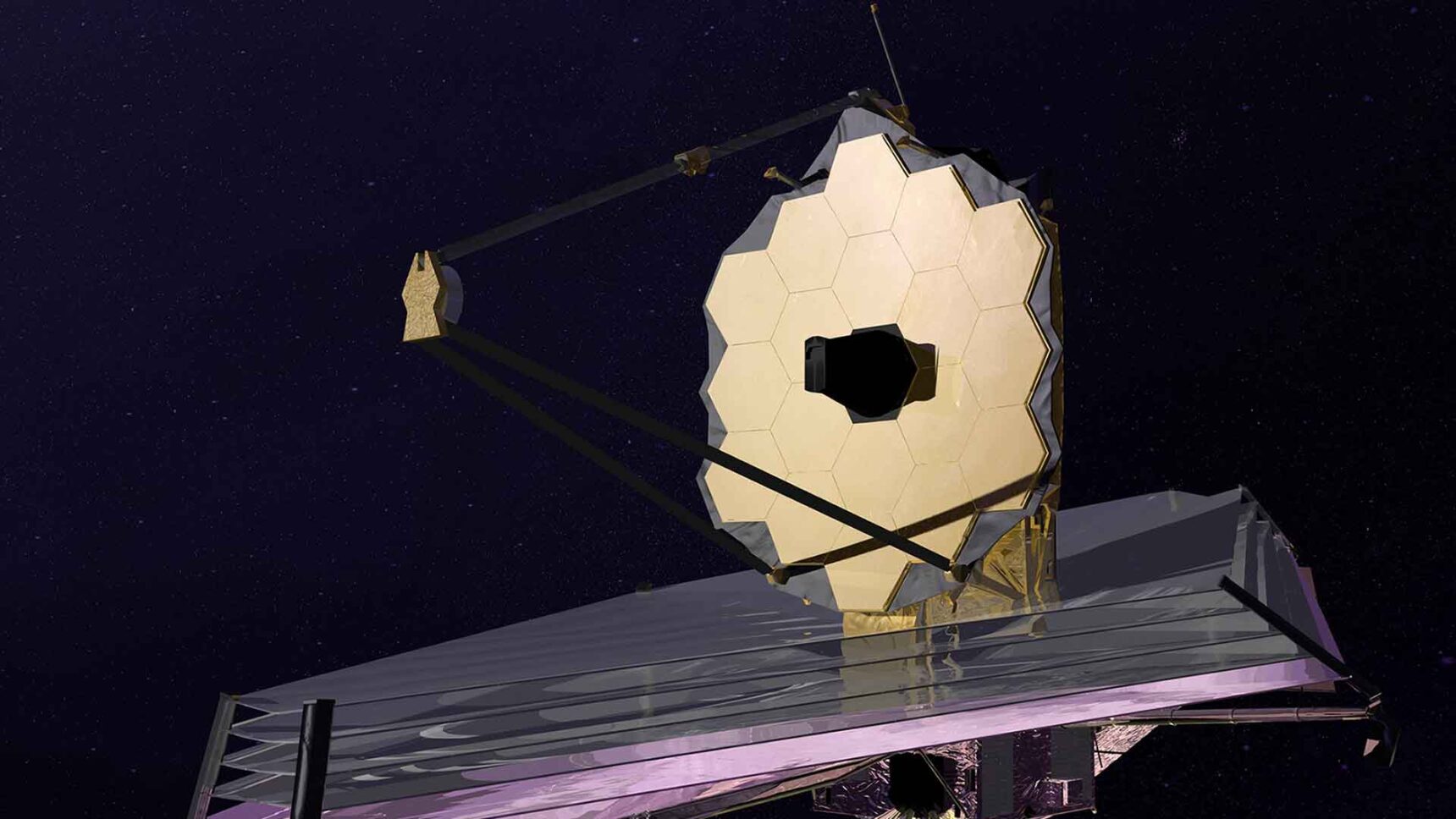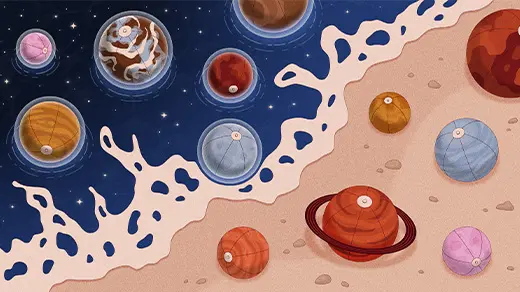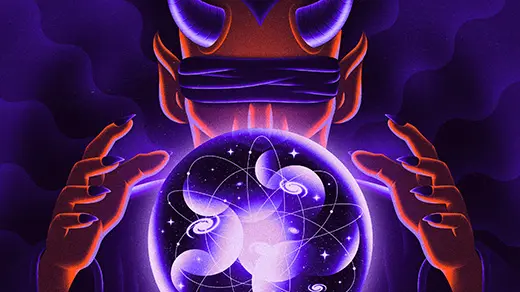The Webb Space Telescope Will Rewrite Cosmic History. If It Works.
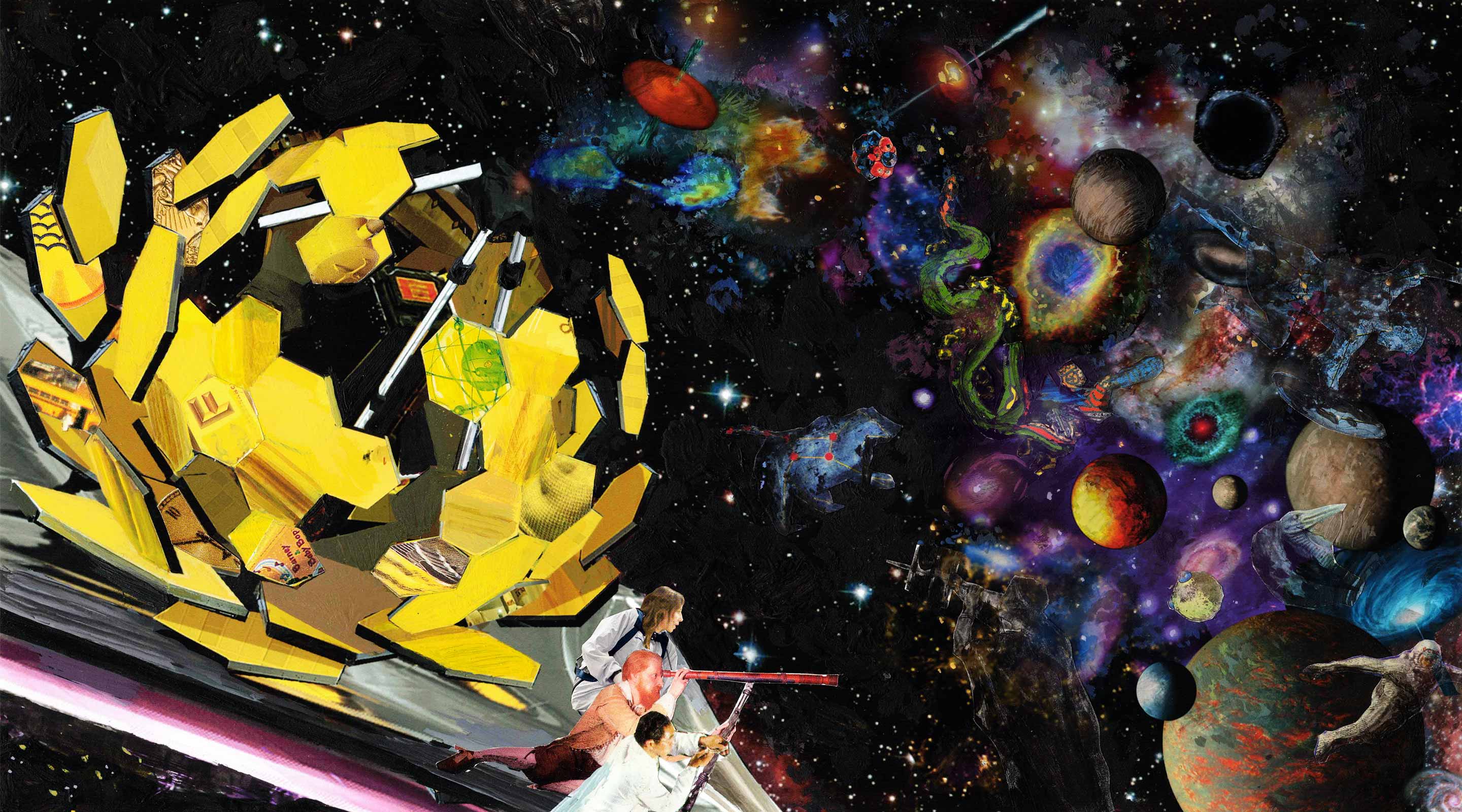
The James Webb Space Telescope promises to revolutionize our understanding of distant planets and deep time.
Dustin Yellin for Quanta Magazine
Introduction
Editor’s note: This article package was awarded the 2022 Pulitzer Prize in Explanatory Reporting.
To look back in time at the cosmos’s infancy and witness the first stars flicker on, you must first grind a mirror as big as a house. Its surface must be so smooth that, if the mirror were the scale of a continent, it would feature no hill or valley greater than ankle height. Only a mirror so huge and smooth can collect and focus the faint light coming from the farthest galaxies in the sky — light that left its source long ago and therefore shows the galaxies as they appeared in the ancient past, when the universe was young. The very faintest, farthest galaxies we would see still in the process of being born, when mysterious forces conspired in the dark and the first crops of stars started to shine.
But to read that early chapter in the universe’s history — to learn the nature of those first, probably gargantuan stars, to learn about the invisible matter whose gravity coaxed them into being, and about the roles of magnetism and turbulence, and how enormous black holes grew and worked their way into galaxies’ centers — an exceptional mirror is not nearly enough.
The reason no one has seen the epoch of galaxy formation is that the ancient starlight, after traveling to us through the expanding fabric of space for so many billions of years, has become stretched. Ultraviolet and visible light spewed by the farthest stars in the sky stretched to around 20-times-longer wavelengths during the journey here, becoming infrared radiation. But infrared light is the kind of atom-jiggling light we refer to as heat, the same heat that radiates from our bodies and the atmosphere and the ground beneath our feet. Alas, these local heat sources swamp the pitiful flames of primeval stars. To perceive those stars, the telescope with its big perfect mirror has to be very cold. It must be launched into space.
The catch is that a house-size mirror is too large to fit in any rocket fairing. The mirror, then, must be able to fold up. A mirror can only fold if it’s segmented — if, instead of a single, uninterrupted surface, it’s a honeycomb array of mirror segments. But in order to collectively create sharp images, the mirror segments, after autonomously unfolding in space, must be in virtually perfect alignment. Spectacularly precise motors are needed to achieve a good focus — motors that can nudge each mirror segment by increments of half the width of a virus until they’re all in place.
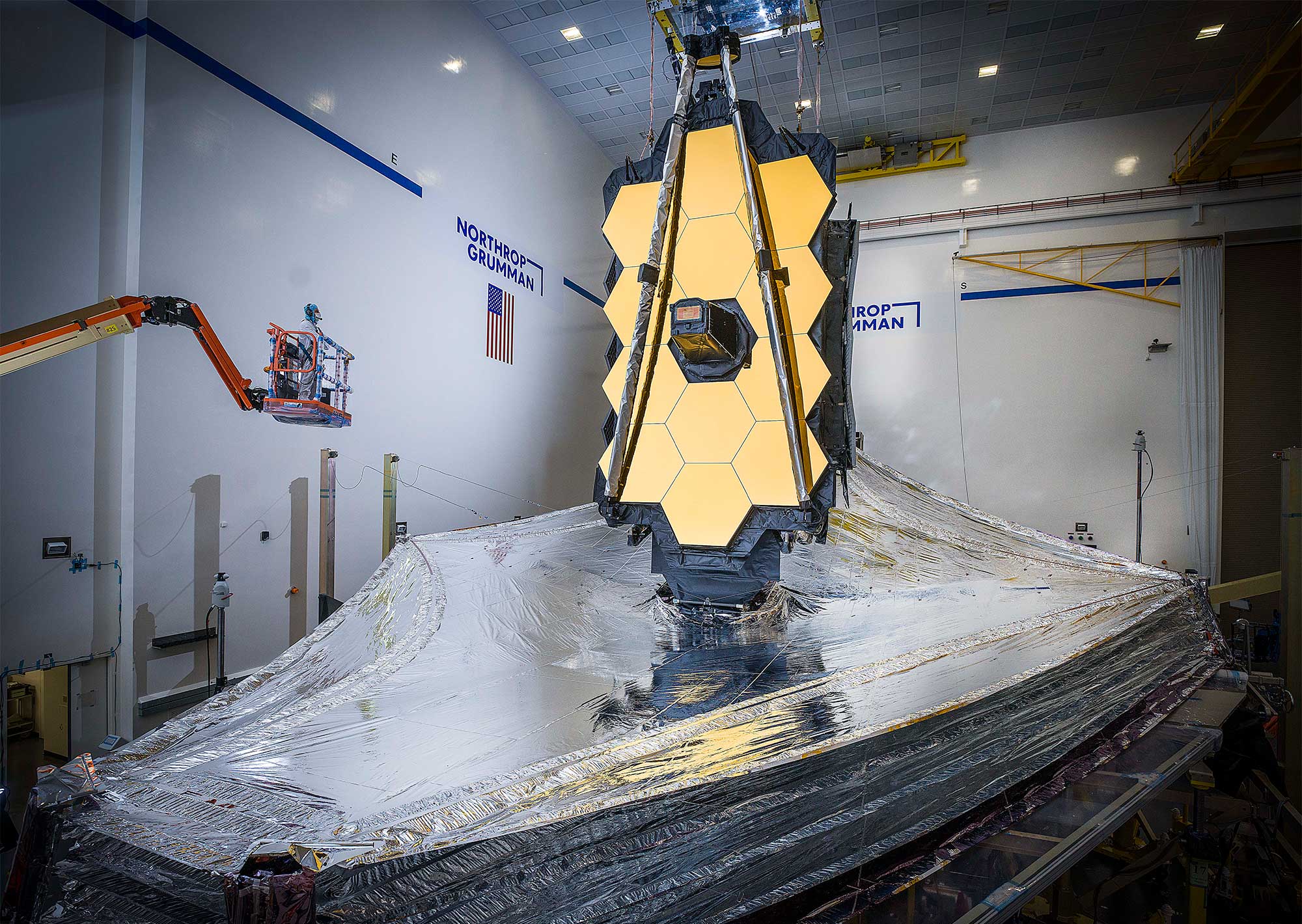
The assembled telescope stands tall with its mirror folded at Northrop Grumman’s facility in California.
Northrop Grumman
The ability to see faint infrared sources doesn’t just grant you access to the universe’s formative chapter — roughly the period from 50 million to 500 million years after the Big Bang — it would reveal other, arguably just as significant aspects of the cosmos as well, from properties of Earth-size planets orbiting other stars to the much-contested rate at which space is expanding. But for the telescope to work, one more element is required, beyond a flawless mirror that autonomously unfolds and focuses after being shot into the sky.
Even in outer space, the Earth, moon and sun all still heat the telescope too much for it to perceive the dim twinkle of the most distant structures in the cosmos. Unless, that is, the telescope heads for a particular spot four times farther away from Earth than the moon called Lagrange point 2. There, the moon, Earth and sun all lie in the same direction, letting the telescope block out all three bodies at once by erecting a tennis court-size sunshield. Shaded in this way, the telescope can finally enter a deep chill and at long last detect the feeble heat of the cosmic dawn.
The sunshield is both an infrared telescope’s only hope and its Achilles heel.
In order to unfurl to large enough proportions without weighing down a rocket, the sunshield must consist of thin fabric. (The whole observatory, for that matter, including its mirrors, cameras and other instruments, its transmitters and its power sources, must have only about 2% of the typical mass of a large ground-based telescope.) Nothing about building a giant yet lightweight infrared-sensing spacecraft is easy, but the unavoidable use of fabric makes it an inherently risky affair. Fabric is, engineers say, “nondeterministic,” its movements impossible to perfectly control or predict. If the sunshield snags as it unfurls, the whole telescope will turn into space junk.
Currently, the telescope — which has, incredibly, been built — is folded up and ready to be placed atop an Ariane 5 rocket. The rocket is scheduled for liftoff from Kourou, French Guiana, on December 22, more than 30 years after its payload, the James Webb Space Telescope (JWST), was first envisioned and sketched. The telescope is 14 years behind schedule and 20 times over budget. “We’ve worked as hard as we could to catch all of our mistakes and test and rehearse,” said John Mather, the Nobel Prize-winning astrophysicist who has been chief scientist of the NASA-led project for 25 years. Now, he said, “we’re going to put our zillion-dollar telescope on top of a stack of explosive material” and turn things over to fate.
The story of JWST’s development over the past three decades has paralleled the tremendous progress we’ve made in our understanding of the cosmos, not least because of Webb’s predecessors. With the Hubble Space Telescope, we’ve learned that stars, galaxies and supermassive black holes existed far earlier in cosmic history than anyone expected, and that they have since undergone radical change. We’ve learned that dark matter and dark energy sculpt the cosmos. With the Kepler telescope and others, we’ve seen that all manner of planets decorate galaxies like baubles on Christmas trees, including billions of potentially habitable worlds in our Milky Way alone. These discoveries have raised questions that the James Webb Space Telescope can address. Astronomers also hope that, as with other telescopes, its sightings will raise new questions. “Every time we build new equipment,” Mather said, “we get a surprise.”
The launch will begin what the astronomer Natalie Batalha called “six months of pins and needles,” as the staggeringly complex telescope will attempt to unfold and focus itself in hundreds of steps. The observatory will spend a month floating 1 million miles to Lagrange point 2. On the way, it will transform into a celestial water lily, positioning its giant blossom of gold-plated mirror segments atop an even bigger silver leaf.
“It will be our own ‘dare mighty things’ moment,” said Grant Tremblay, an astrophysicist at Harvard University who served on the telescope’s time allocation committee. “It’s going to do amazing things. We’ll be in The New York Times talking about how this is witnessing the birth of stars at the edge of time, this is one of the earliest galaxies, this is the story of other Earths.”
“Please work,” Tremblay added, his eyes fluttering upward.
From Smooth to Lumpy
The last time NASA launched an observatory of such significance — the Hubble Space Telescope, in 1990 — it was a disaster. “Absolutely catastrophic,” the veteran astronomer Sandra Faber told me. Faber was on the team that camped out at NASA’s Goddard Space Flight Center in Greenbelt, Maryland, to diagnose the disorder. From the way a star in one of Hubble’s photos looked like a ring, she and a colleague inferred that the primary mirror — the big, concave one that bounced light to a secondary mirror that then reflected it onto a camera lens — had not been ground down to quite the right concavity to focus the light; it was half a wavelength too thick around the edge. If the primary and secondary mirrors had been tested together before launch, this aberration would have been noticed, but in the rush to get the long-delayed and over-budget telescope aloft, that testing never happened.
Some NASA leaders called for abandoning the telescope, which was already a controversial project. Instead, Senator Barbara Mikulski of Maryland secured the funds for a rescue mission. Fixing it was possible because, as an optical telescope that’s sensitive to the colors of the rainbow rather than to infrared light, Hubble can get a clear view from low-Earth orbit, only 340 miles up, instead of having to travel a million miles away. In 1993, the space shuttle docked with Hubble, and astronauts installed a sort of contact lens. The telescope would go on to revolutionize astronomy and cosmology.
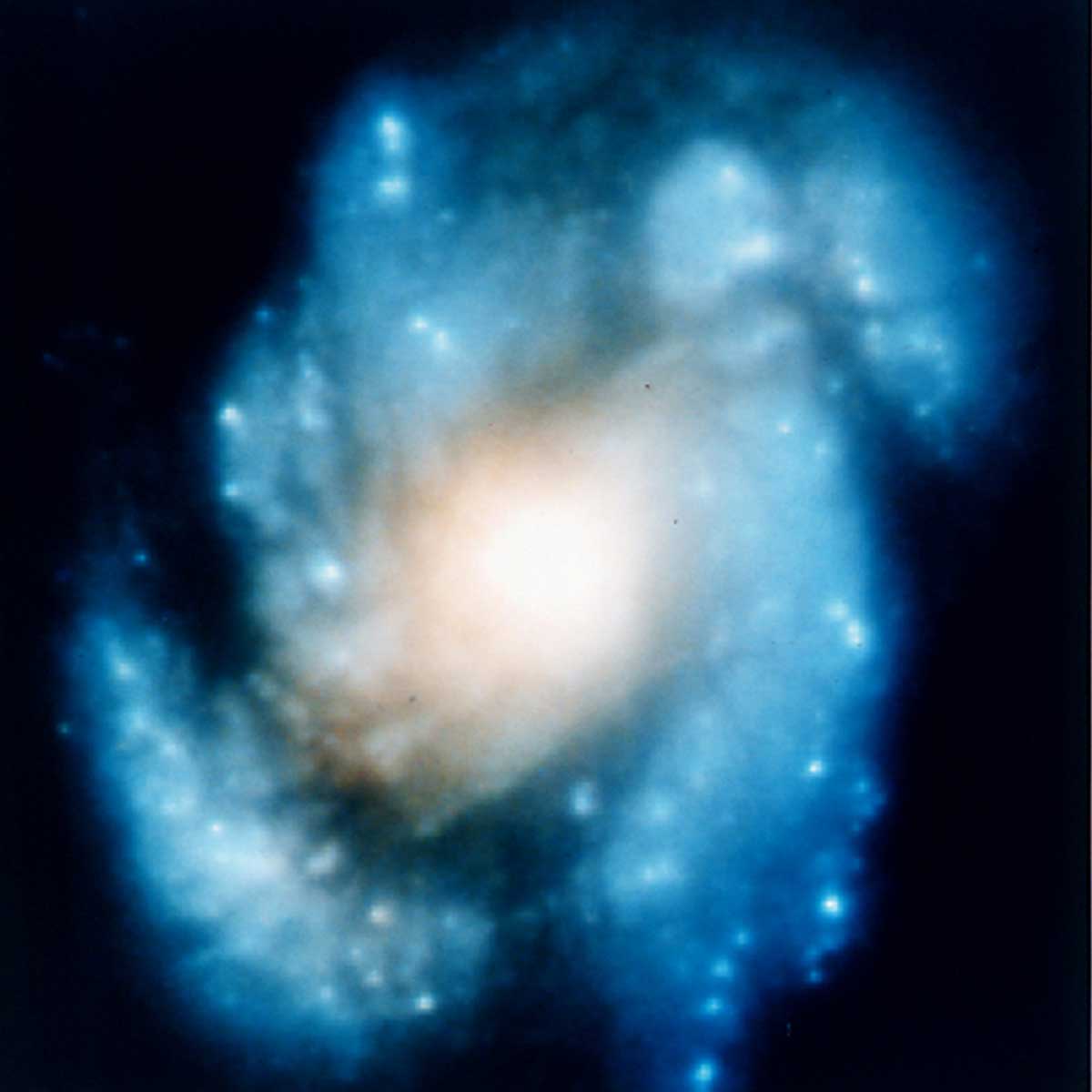
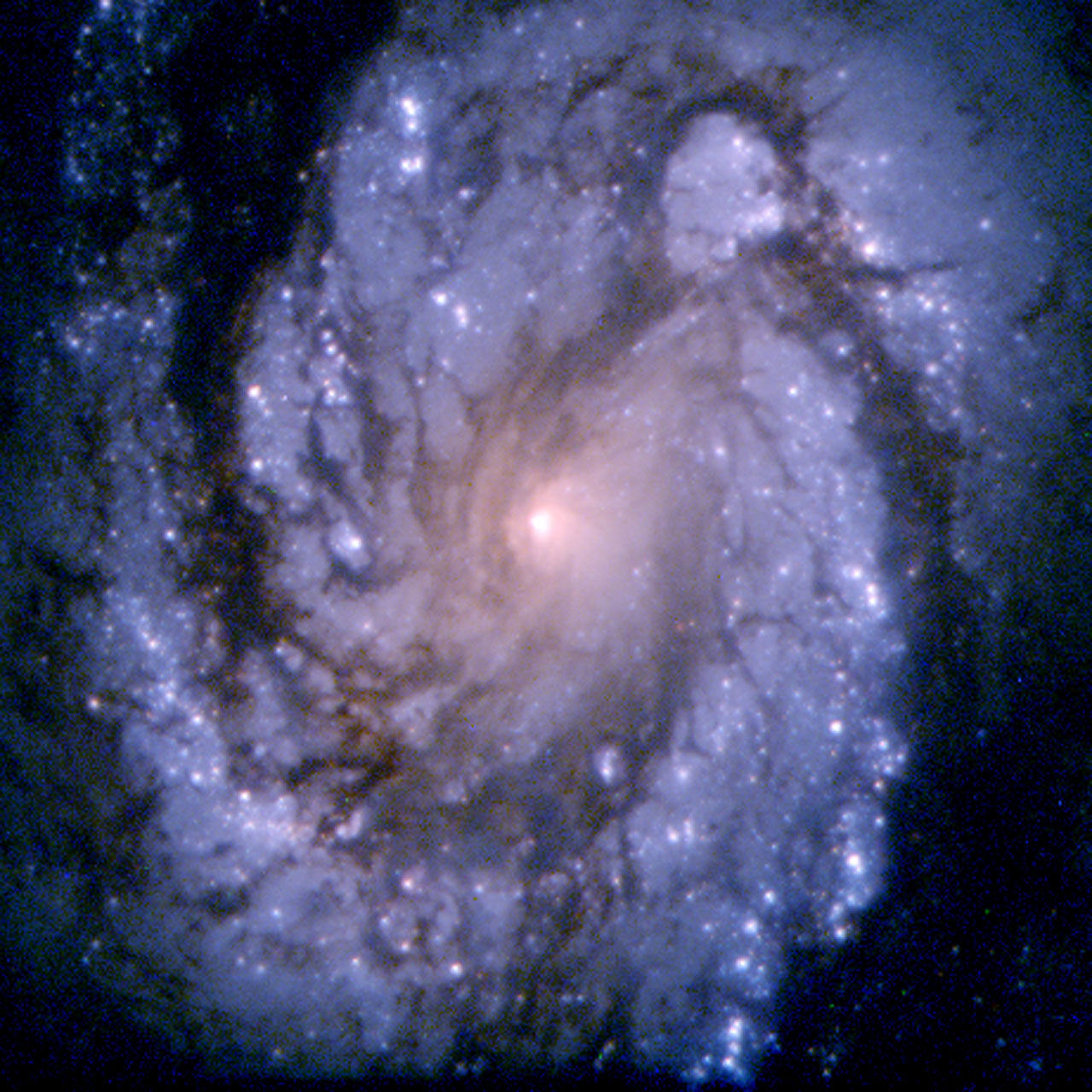
Images of the galaxy M100 taken by the Hubble Space Telescope before and after astronauts installed a corrective lens on the telescope’s primary mirror in December 1993.
NASA
Perhaps the most important question about the universe for much of the 20th century was whether it had a beginning or if it has always been this way. For the British cosmologist Fred Hoyle and other believers in the latter “steady state” theory, “the compelling logic was simplicity,” said Jay Gallagher, an astronomer and professor emeritus at the University of Wisconsin, Madison. “That at one point something changed and the universe created matter, why did that have to be?” Hoyle, the steady-state proponent, attributed his rivals’ belief in the “Big Bang” (as he dubbed it) to the influence of the Book of Genesis.
Then came a hiss in a radio antenna at Bell Labs in New Jersey in 1964. The hiss was generated by microwaves arriving from everywhere in the sky, exactly as predicted by the Big Bang theory. (The light was released in an early phase transition as the hot, dense universe cooled.) The discovery of the cosmic microwave background, as it was called, did not immediately end the debate — steady-state folks like Hoyle distrusted its interpretation and clung to their theory for many more decades. But for others, who recognized the afterglow of the Big Bang when they saw it, the CMB created a puzzle. The near-perfect uniformity of microwaves coming from all parts of the sky indicated that the newborn universe was astonishingly smooth — a purée of matter. “The puzzle is we see a very lumpy universe today,” said Faber, who was a graduate student studying galaxies in the late ’60s. “So the first challenge in understanding galaxies is to understand how the universe goes from smooth to lumpy.”
Cosmologists knew atoms must have gradually clumped together because of gravity, eventually fracturing into structures like stars and galaxies. But on paper, it seemed that the growth of structure would have been extraordinarily slow. Not only was matter initially smoothly distributed, and thus pulled in no particular direction by gravity, but the expansion of space and the pressure created by light itself would both have worked to separate matter, counteracting its weak gravitational attraction.
Samuel Velasco/Quanta Magazine
Enter dark matter. In the 1970s, Vera Rubin of the Carnegie Institute of Washington observed that the outskirts of galaxies rotate much faster than expected, as if whipped around by some extra, invisible source of gravity. This evidence for substantial missing matter in and around galaxies, dubbed dark matter, matched Fritz Zwicky’s 1930s observations that galaxies seem to attract each other more than they should based on their luminous matter alone. Also in the ’70s, Jim Peebles and Jerry Ostriker of Princeton University calculated that rotating galactic disks consisting only of stars, gas and dust should become unstable and swell into spheres; they posited that invisible matter must be creating a stronger gravitational well within which the visible disk rotates. In 1979, Faber and Gallagher wrote an influential paper compiling all the evidence for dark matter, which they pegged at about 90% of the matter in the universe. (The current estimate is about 85%.)
These researchers realized that dark matter, with its substantial gravity and imperviousness to light’s pressure, could have bunched up relatively quickly in the early universe. Peebles, who won half of the 2019 Nobel Prize in Physics for his contributions to cosmology, developed a qualitative picture in which dark matter particles would have glommed together into clumps (known as halos) that then combined into bigger and bigger clumps. The British astrophysicist Simon White demonstrated this “hierarchical clustering” process in primitive 1980s computer simulations. Though visible matter was at that time too complicated to simulate, researchers surmised that the conglomerating dark matter would have brought luminous matter along for the ride: Corralled within dark matter halos, atoms would have bumped together, heated up, sunk toward the center and eventually gravitationally collapsed into stars and disk-shaped galaxies.
Although most cosmologists became convinced of this picture, a big question was how variations in the density of matter initially set in, jump-starting the gravitational clustering process. “People had no clear idea about what were reasonable initial conditions about the formation of cosmic structure,” White, who is now retired and living in Germany, told me over Zoom. “You could run these simulations, but you didn’t have any idea what you should put in at the beginning.”
“SPECTACULAR REALIZATION,” the cosmologist Alan Guth scrawled in his notebook in 1979. He had calculated that if space suddenly blew up like the surface of a balloon at the start of the Big Bang, this would explain how it got so huge, smooth and flat. Cosmic inflation, as Guth dubbed the primordial growth spurt, quickly became popular as a Big Bang add-on. Cosmologists soon noted that, during inflation, quantum fluctuations in the fabric of space would have gotten frozen in as space blew up, producing subtle density variations throughout the universe. The putative dense spots created by inflation could have served as the seeds of future structures.
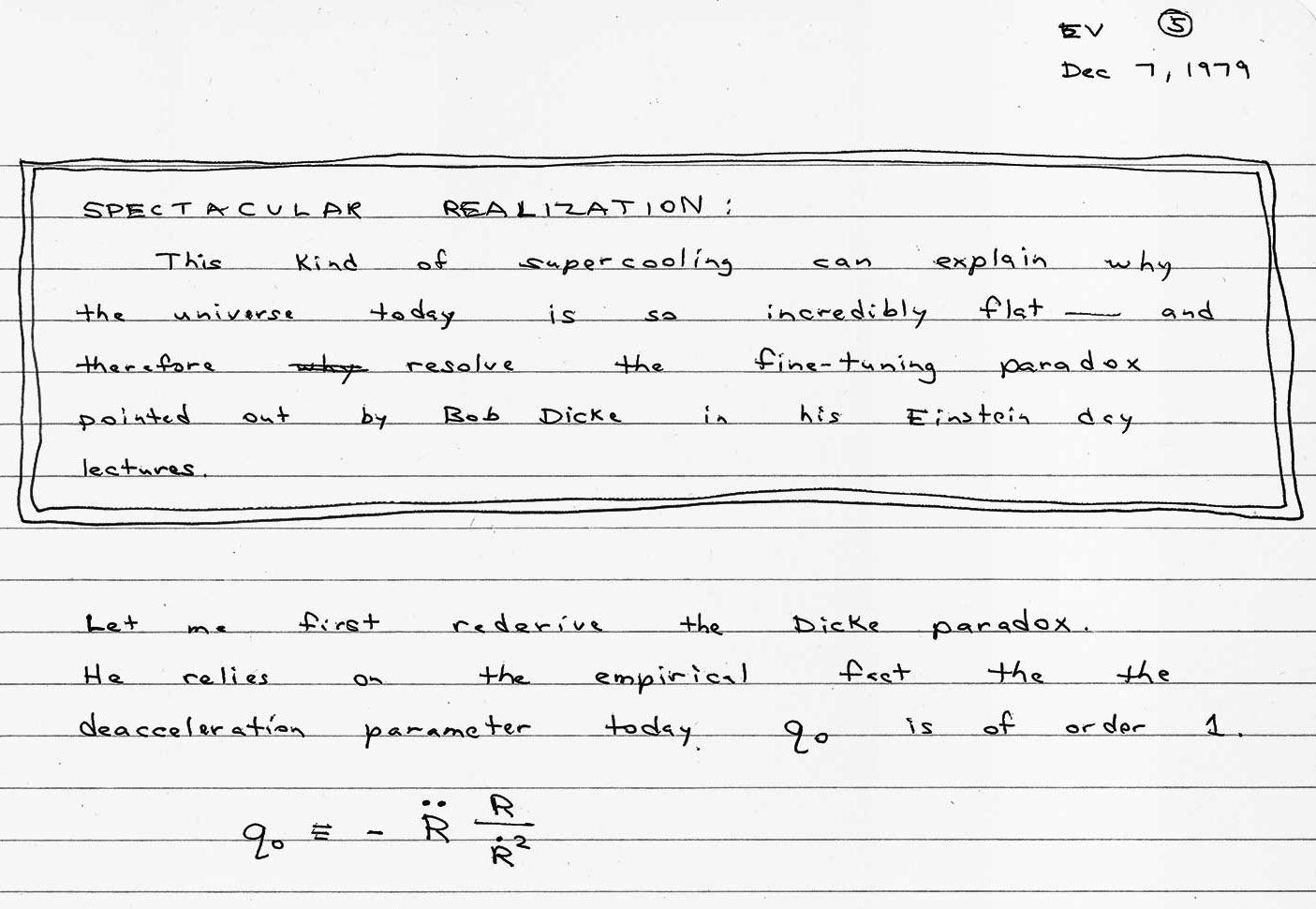
In 1979, Alan Guth realized that a burst of exponential expansion at the start of the Big Bang would explain several puzzling properties of the universe.
On loan to the Adler Planetarium’s collection by Dr. Alan Guth
These tiny density variations were indeed measured in the CMB in the early 1990s — the feat that earned John Mather, the Webb telescope’s top scientist, his Nobel. But even before they were measured, people like Faber were working the dense spots into the plot. In 1984, she and three co-authors published a paper in Nature that strung everything together. “It’s the first soup-to-nuts description of how inflation can make fluctuations and what the fluctuations would do later to make galaxies,” she said.
But the story was speculative from start to finish. And even if it was broadly true, key dates and details were unknown.
One of the Hubble telescope’s most impactful discoveries, and a major impetus for building its successor, the Webb, occurred in 1995, two years after its corrective lens was installed. Bob Williams, then the director of the Space Telescope Science Institute in Baltimore, the operations center for Hubble as it will be for Webb, decided at the suggestion of some postdocs to devote all 100 hours of his “director’s discretionary time,” with which he could point Hubble wherever he wanted, to pointing it at nothing — a dark, featureless little patch of sky narrower than a thumbnail moon. The idea was to look for any incredibly faint, distant objects that might have been hiding beyond the reach of less sensitive telescopes.
Colleagues thought this was a waste. The late John Bahcall tried to talk Williams out of it. Bahcall and his wife, Neta Bahcall, well-known astrophysicists, were typical in thinking that structures like stars and galaxies arose relatively late in cosmic history. If so, then trying to resolve faint, faraway, long-ago objects wouldn’t work, because none would exist. The Bahcalls and many other theorists thought Williams’ photo would come out dark.
But during the 100-hour exposure, the lid of a treasure chest opened: The small rectangle of space glittered with thousands of galaxies of all shapes, sizes and hues. Astronomers were stunned.
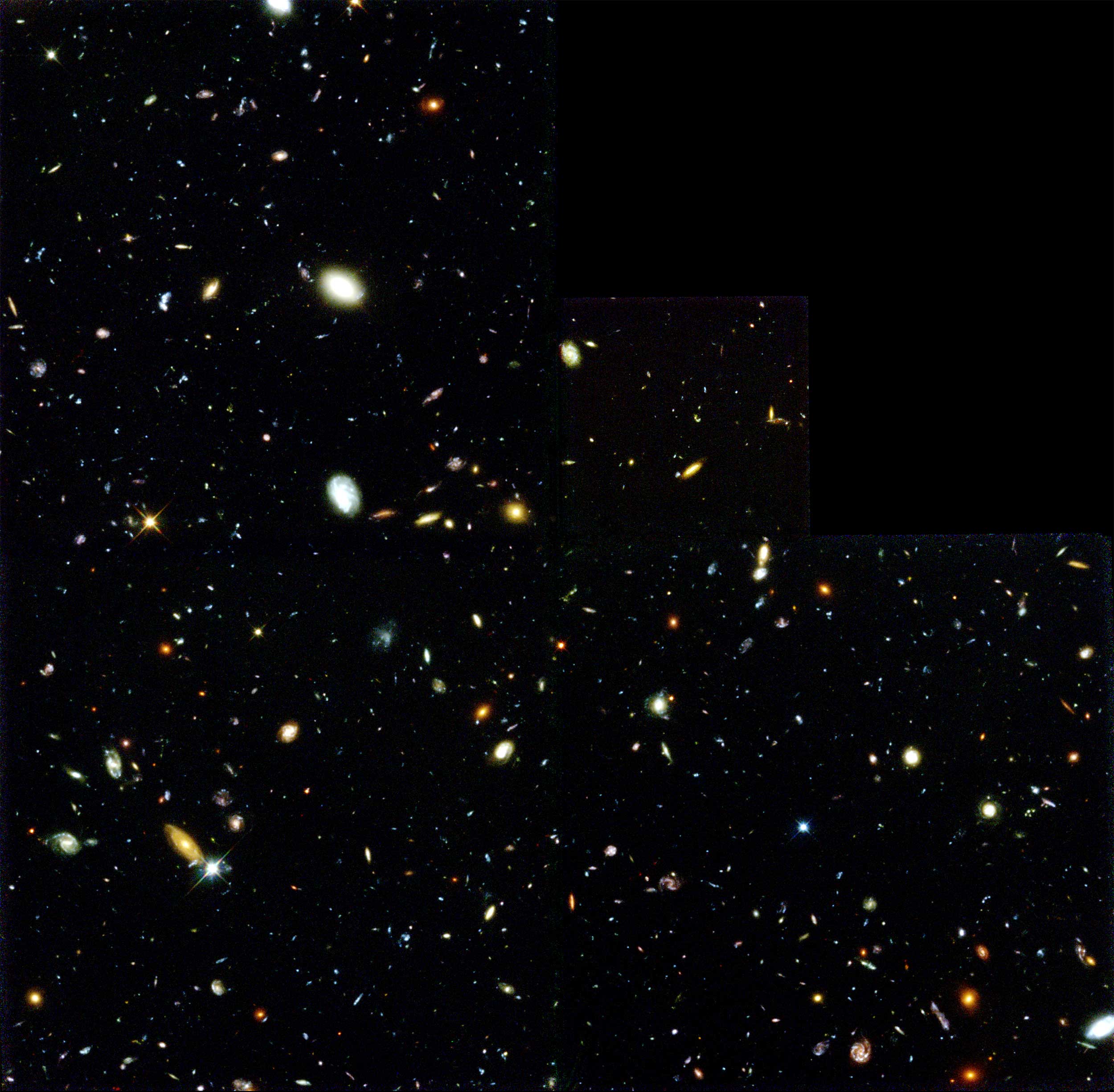
Farther-away galaxies in the Hubble Deep Field photo appear redder, since their light has traveled longer through expanding space to get here and therefore has been stretched, or “redshifted,” to longer wavelengths. Through this color-coding, the Deep Field image provides a 3D view of the cosmos and a timeline of galaxy evolution. Galaxies appear at all ages and stages of development — proof that the universe has changed radically over time. “Gone out of the window, never to be heard from again, was the steady-state theory,” said Faber. “That was a great intellectual breakthrough, that you could take one picture with a telescope, you could look back in time, and you could see that the universe was a different beast back then.”
The photo showed that bright objects formed in the universe far more quickly than most experts expected. This bolstered the theory that they didn’t form on the strength of their gravity alone, but were carried on the backs of merging dark matter halos.
Galaxies in early times were strange-looking — small and disheveled, like ugly ducklings that would take billions of years to grow into swans. “The beautiful universe with the beautiful [spiral and elliptical galaxies] of today is really kind of a late development,” Faber said, “and that too was visible in the picture.” Some of the duckling galaxies were colliding and merging, supporting the hierarchical clustering theory of cosmic structure growth. And clumps of stars in the long-ago galaxies were surprisingly bright, indicating that the stars were far more massive and luminous than modern, sun-type stars.
Astronomers observed that most galaxies reached peak luminosity, forming stars most quickly, around “redshift 2” — the distance from which light has stretched to twice its emitted wavelength by the time it gets here, corresponding to about 2 billion years after the Big Bang. After that, for reasons now thought to relate to the mysterious supermassive black holes growing at galaxies’ centers, many galaxies dimmed.
The most striking thing about the timeline of galaxy evolution visible in the Deep Field photo, though, was that there’s no beginning in sight. As far as Hubble’s glass eye could see, there were galaxies. In even deeper-field photos taken with upgraded cameras that astronauts installed on the telescope later, smudges of light have been tentatively spotted as far off as redshift 10, which corresponds to around 500 million years after the Big Bang. It’s now thought likely that structures started forming hundreds of millions of years before that.
But galaxies in the process of forming, their matter somehow fragmenting into stars for the first time, are both too far and too faint for Hubble to detect, and too redshifted: The light from these galaxies has stretched straight out of the visible part of the electromagnetic spectrum and into the infrared. To see them, we need a bigger, infrared-sensing telescope.
“What Hubble succeeded in doing with the Hubble Deep Field is finding that there were galaxies at redshifts much higher than we thought,” Neta Bahcall told me. “A question for James Webb is when did it start, and how did it start so early.”
Planets Out the Wazoo
In October 1995, two months before Hubble stared at nothing and glimpsed the history of time, the Swiss astronomer Michel Mayor announced another major discovery at a conference in Florence, Italy: He and his graduate student, Didier Queloz, had spotted a planet orbiting another star.
In the back of the auditorium at Mayor’s talk, Natalie Batalha, then a graduate student from California, failed to register the importance of what she had just heard. “It’s funny how these things happen, because in retrospect it was a pivotal moment,” Batalha said recently, framed by three planets orbiting a star in her virtual background. “It was the dawn of this new era of exoplanet exploration, but was also a transformational moment in my life, and I didn’t know it yet.”
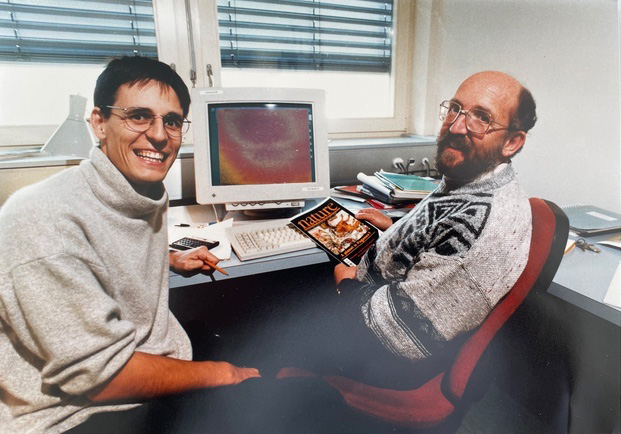
Didier Queloz (left) and Michel Mayor in 1995, shortly after the publication of the Nature paper announcing the discovery of the exoplanet 51 Pegasi b.
Courtesy of Didier Queloz
At the time, exoplanet searching was a scientific backwater, and Mayor and Queloz’s method had seemed like a long shot. Using a spectrograph, which splits starlight into its color components, they monitored more than 100 sunlike stars hoping to detect a Doppler shift, where an object looks bluer or redder when it’s approaching or receding, respectively. This could indicate that the star is wobbling because it is disturbed by the gravity of an orbiting planet. The technique seemed far-fetched because a planet would have to be ludicrously heavy and close to its host star to set the star wobbling enough to be seen with the best available spectrographs. Yet when Mayor and Queloz looked at 51 Pegasi, a sunlike star 50 light-years away, the wobble was huge: Eliminating other possibilities, they determined that a Jupiter-size planet whips around the star once every 4.2 days, eight times closer in than Mercury’s distance from our sun.
Not only had Mayor and Queloz bagged an exoplanet (and, eventually, the other half of the 2019 Nobel Prize in Physics, shared with Peebles), the planet itself, 51 Pegasi b, single-handedly upended the textbook understanding of what solar systems are like. As the planetary scientist Heidi Hammel put it, “We had been taught a lovely fairy tale about how our solar system formed,” one designed to explain why rocky planets lie close to a star while giant gas and ice planets form far away. So what was 51 Pegasi b, a “hot Jupiter,” doing practically grazing its sun?
Batalha remembers the audience’s reaction in Florence to Mayor’s presentation — silence. Soon enough, though, skepticism gave way to more hot-Jupiter discoveries. And as telescopes and techniques improved, other exoplanets showed up as well. Sixteen years after that day in Florence, Batalha would lead the NASA team that discovered the first confirmed rocky exoplanet, Kepler 10b.

Natalie Batalha, an astronomer at the University of California, Santa Cruz, led the team that discovered the first rocky exoplanet. She’ll oversee some of JWST’s first exoplanet observations.
Marcos Rocha for Quanta Magazine
Growing up in California’s East Bay, Batalha (then Natalie Stout) hardly thought about science, though she was thrilled, at age 17, by Sally Ride’s trip to space in 1983. Though neither of her parents went to college, she was accepted at the University of California, Berkeley, entering as a business major. But then, while she was doing laundry one weekend sophomore year, she remembers suddenly saying to herself: “‘Forget talent, resources. If I could do anything in the world, what would it be?’ And surprisingly the answer came to me immediately, and it was to work for the space program.”
She enrolled in a physics class. She struggled, but loved it. That everyday happenings could be explained with mathematical equations “gave meaning to my life,” Batalha said. “It made me see my place in the universe differently. I thought that if you could write an equation to explain the interference off of thin films” — the reason oily puddles create rainbow shimmers — “what limit is there to what we can know about the natural world?”
Batalha thought she’d combine science with business somehow. She continued taking classes, then landed a summer internship at the Wyoming Infrared Observatory, one of the few ground-based infrared telescopes. When she got there, she told her adviser and cohort that she wasn’t like them, that she wasn’t planning on being a scientist. But when her adviser gave her a problem to work on and she solved it, which later led to a publication, he told her “not to sell myself short,” she said, and to knock on Gibor Basri’s door when she got back to Berkeley.
Basri, a stellar astronomer, put her to work analyzing star spectra. Experiencing the scientific method firsthand hooked her. She also fell in love with her office mate, Basri’s postdoc, Celso Batalha. She married him, went to graduate school in astronomy at the University of California, Santa Cruz, and had a son, Nolan, and daughter, Natasha, in quick succession. Two more kids would follow. Over those years, she and Celso Batalha, who is Brazilian, moved the family back and forth between California and Rio de Janeiro. Life in Rio was beautiful but complicated; she remembers driving past some slums and seeing a charred corpse on the side of the road. They eventually settled in the Bay Area.
Considering herself primarily a mother who did astronomy on the side, Batalha never attended conferences. But when she was invited to present new data on star spots at a stellar spectroscopy meeting in Vienna in the fall of 1995, she made an exception, taking her parents along to Europe to babysit her youngest child. She decided to stay for another conference on planets that was taking place in Florence the following week. It was on the last day of the second conference that Batalha noticed a TV camera setting up for a talk that had been added to the schedule at the last minute. “Then Michel Mayor gets up and just so nonchalantly talks about this planet discovery,” she said.
At first, Batalha thought little about the newfound hot Jupiter and kept studying star spots in Santa Cruz. Then a year or so later, she heard about a scientist at NASA’s Ames Research Center in Silicon Valley named Bill Borucki who was determined to build a space telescope capable of detecting rocky, Earth-size exoplanets, not just gas giants. Borucki planned to use the transit method: Instead of tracking changes in the color of starlight as Mayor and Queloz had done, he would look for periodic dips in the starlight’s intensity caused by an orbiting planet crossing in front of the star, blocking a small bit of its light.
Batalha didn’t think this would work. Star spots, as she happened to know, are about the same size as Earth. So she thought a small transiting planet would be indistinguishable from a star spot sweeping around on a rotating star. She wrote to Borucki about the problem. He wrote back and said NASA had rejected his proposal in part for that very reason, and would she come work with him at Ames to figure out how to tell star spots apart from rocky worlds?
She would, and they did. Next time, NASA greenlit Borucki’s proposal, and Batalha became a project scientist. The Kepler Space Telescope — designed by Borucki and his team to continually monitor the brightness of approximately 150,000 stars in search of the dips of transiting planets — lifted off in March 2009. The Batalhas took all four kids to Cape Canaveral, Florida, for the launch.
Samuel Velasco/Quanta Magazine; Source: NASA
Kepler delivered on Earth-size planets. “Kepler 10b was identified in the first 10 days of data we got back from the spacecraft,” Batalha said. When they graphed the brightness of the host star over time, the dip was visible to the eye. Follow-up observations from the ground confirmed it was a genuine planet and one that, based on its mass and radius, had to be rocky. Batalha presented the unequivocal detection in January 2011, following a more tentative claim of a rocky exoplanet labeled CoRoT-7b by astronomers in Europe. Neither Kepler 10b nor CoRoT-7b earned the coveted designation “Earth-like,” because they orbited near their parent star rather than in the “habitable zone,” where water is liquid. (The first rocky, watery and potentially Earth-like planet, Kepler 186f, made headlines in 2014. Batalha wasn’t formally involved with the analysis.)
The Kepler telescope, before being prematurely hobbled by the failure of two of its motors, discovered more than 2,600 exoplanets. More than 4,500 have been counted in all, a sufficient number for astronomers to study their statistical properties. Just as 51 Pegasi b had suggested, our solar system is atypical. For instance, the most common type of planet in the galaxy is a size we don’t have, in between rocky planets and giants. Planetary astronomers don’t yet understand the surplus of these so-called super-Earths or sub-Neptunes, or what these midsize planets are like, or how they form. New principles of planet formation and evolution are needed.
Extrapolating the data so far, researchers think that our galaxy holds billions of rocky, watery planets, suggesting that life, too, might be common. Until we find evidence of life actually inhabiting another planet, though, it remains possible that its emergence on Earth was a fluke, and that we are alone.
Happily, the Webb telescope will be powerful enough to probe the atmospheres and climates of other Earths — or even, if we’re very lucky, find evidence of an actual alien biosphere.
“Infrared is fantastic for exoplanets,” Batalha said.
One Strike and You’re Out
One morning in 1987, the astrophysicist Riccardo Giacconi, who was then the director of the Space Telescope Science Institute (STScI) and of the yet-to-launch Hubble, asked deputy director Garth Illingworth to start thinking about Hubble’s successor. “My immediate reaction is, ‘Argh, we haven’t even got Hubble launched yet, and we’ve got a million things to do on there — it has major problems — so how can we do this as well?’” Illingworth recalled recently. “He said, ‘Trust me, you’ve got to start early because I know it takes ages to do this.’” Hubble had been under development since around 1970, spearheaded in its early years by the NASA astronomer Nancy Roman following decades of campaigning by Princeton’s Lyman Spitzer; they are known as the mother and father of Hubble.
Illingworth, who is from Australia, got together with his STScI colleagues Pierre Bely of France and Peter Stockman of the U.S. to brainstorm about the next-generation space telescope. They had basically nothing to go on. “We started thinking about what would be good to go beyond Hubble and to complement whatever it did and explore new areas,” Illingworth said, “and the IR was one clear area.” Infrared light is prohibitively difficult to observe from the ground. The trio figured that in space, where the infrared background is more than 1 million times lower, there would be plenty to see. “When you put a powerful new capability out there, you open an immense number of scientific horizons.”
For an IR telescope to be as sensitive as Hubble, which has a 2.4-meter-wide primary mirror, Illingworth, Bely and Stockman realized that it would need to be significantly bigger, since it detects bigger wavelengths. They considered that the mirror might have to fold to fit in a rocket. They also knew it had to be cold, otherwise its heat would saturate its own sensors. Rather than actively cool the telescope, they thought to exploit the extreme frigidity of outer space by blocking the heat of the Earth, moon and sun. Their vague conception of a large, passively cooled infrared telescope, greatly elaborated upon, would become the cargo now awaiting launch in Kourou.
Leading astronomers convened at STScI in 1989 to discuss the science that an infrared space telescope might be good for. Discussions slowed during Hubble’s disastrous start and salvation, then picked up again in the mid-’90s. In 1995, John Mather, a reedy, gentlemanly astrophysicist at the Goddard Space Flight Center, got a call from NASA headquarters asking if he’d like to join the project. Realizing that an infrared telescope “would do so much for so many people,” he dropped everything and signed on. He’s been JWST’s top scientist ever since.
Mather calls himself a “theoretical instrument builder.” He started building telescopes as a kid in pastoral New Jersey, assembling parts from catalogs in the hope of getting a closer look at the surface of Mars. As a young man in the 1970s, Mather worked on a balloon-borne instrument that failed; he and his colleagues concluded that they hadn’t tested it enough before launch. “Murphy’s law had been proven one more time,” he wrote in an autobiographical account. But lessons learned led to the triumph of COBE, the NASA satellite experiment for which he and George Smoot would share the Nobel. In the early ’90s, COBE measured the subtle variations in the cosmic microwave background that are thought to have seeded all later cosmological structures. In Mather’s mind, theorizing about the cosmos is fine, but you need ingenious instruments to know anything for sure. “So let’s build the equipment,” he told me this fall. “To me that’s a heroic thing to do.”
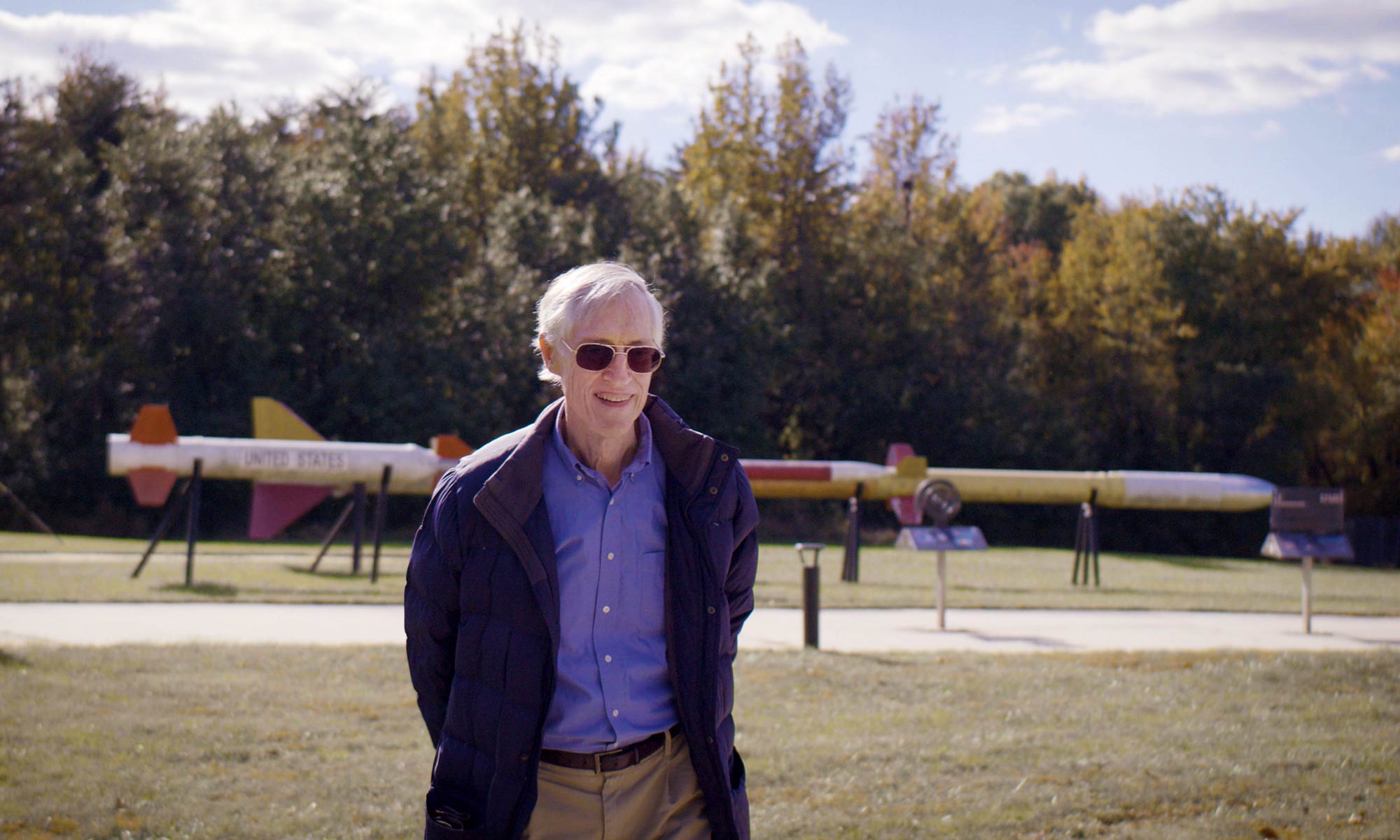
John Mather, an astrophysicist at NASA’s Goddard Space Flight Center, has been the senior project scientist for the Webb telescope for a quarter century.
Umit Gulsen for Quanta Magazine
Mather had contemplated wild designs, including telescopes that fold. In the difficult budgetary climate of 1996, however, a committee of top astronomers studying the infrared telescope concept proposed a 4-meter mirror, which would fit in a rocket fairing, dramatically cutting costs and complexity. Illingworth thought this was “stupid. It was not going to be as good as Hubble.” NASA’s leader at the time, Dan Goldin, evidently felt similarly. At the American Astronomical Society meeting that year, Goldin said in an address: “Why do you ask for such a modest thing? Why not go after 6 or 7 meters?” As committee member Wendy Freedman remembers it, “Goldin essentially said, ‘You guys are really a bunch of scaredy-cats.’” He got a standing ovation. “In my mind he saved the telescope,” said Illingworth. It would be bigger. It would also have to fold after all.
After some heady talk about 8 meters, in 2001 NASA finally settled on 6.5 meters for the segmented mirror’s diameter, giving the next-generation telescope more than six times Hubble’s light-collecting area. The question was: How can you fit a 6.5-meter-wide mirror in a 5.4-meter-wide rocket fairing?
“A big part of the design is how do you fold it up,” Mather said. Outside contractors developed competing mirror designs. Lockheed Martin’s mirror folded like six petals of a flower, Ball Aerospace’s like a drop-leaf tabletop. TRW proposed putting mirror segments in place the way an old jukebox puts records down. After mulling over the proposals for a year, Mather and his team adopted bits and pieces from each. The main contract went to TRW because of the company’s extensive experience building complex satellites for the U.S. military and its successful construction of the Chandra X-ray observatory. (TRW was soon purchased by Northrop Grumman.) The mirror design would be closer to Ball Aerospace’s: an array of 18 hexagonal segments forming a larger hexagon that would fold on two sides. Mike Menzel, who spearheaded Lockheed Martin’s proposal, was brought on by NASA as Webb’s chief engineer.
The mirrors would be made of beryllium — light, strong, stiff stuff that’s toxic in powder form (“Beryllium is a pain in the neck, but it’s the only thing that would work,” according to Mather). Powdered beryllium was pressed into blocks in Ohio, then cut to shape in Alabama. The 18 mirror segments were then topped with a layer of gold, which is supremely reflective of infrared light, and polished in a California factory built specifically for the purpose. “Shaping and polishing telescope mirrors is a dark art that goes back hundreds of years,” said Sarah Kendrew, a Belgian-British astronomer who works on MIRI, one of Webb’s instruments.
Motors with unprecedented finesse would be needed to bring the hexagonal mirror segments into collective focus in space. “That’s something we had to invent right away,” Mather said. “If you can’t do that, you can’t make the whole observatory work.” Ball Aerospace delivered actuators capable of nudging each of the gold hexagons in 10-nanometer increments, one ten-thousandth the width of a hair. Mather said the motors work by “flexing,” or “converting a big motion into a tiny motion,” though Ball’s design, despite being taxpayer-funded, is proprietary. “When we take a picture of the telescope we have to make sure no one could see the motors,” he said.
Samuel Velasco/Quanta Magazine; Matt Twombly for Quanta Magazine. Source: NASA
In 2002, the telescope got a name. NASA administrator Sean O’Keefe broke a tradition of naming telescopes for scientists — the Hubble telescope, for instance, refers to the American astronomer Edwin Hubble — and instead honored an earlier administrator, James Webb, who was head of the space agency during the Apollo era. The choice was immediately unpopular with astronomers and has grown increasingly so. Last year, 1,200 astronomers signed a petition to rename the telescope after claims that Webb either aided or chose to ignore the firing of gay government employees during the Lavender Scare. After an investigation, NASA announced in October that historians found no evidence warranting a name change.
Various institutions, from the University of Arizona to the European Space Agency, signed up to build the cameras, spectrographs and coronagraphs that will swivel into place at the focal point of the optics, slicing and dicing different chunks of the pooled infrared light. In exchange, these institutional partners will command extensive telescope time.
As for the sunshield, the flimsy material on which the infrared telescope’s fate rests, the team quickly settled on Kapton, a slithery silver plastic that looks like the inside of a potato chip bag but has the thickness of a human hair. Since it might tear, the sunshield would need many layers for redundancy — the team decided on five — and the layers would have to be unfurled, separated and held taut by a system of booms, cables and strings. Propulsion systems and solar panels would go on the sunward side, and the optics and instruments, which must operate below minus 223 degrees Celsius, would huddle on the dark side. “JWST has a lot of firsts, an awful lot of significant firsts,” Menzel, the chief engineer, told me, “but that sunshield is one of them.”
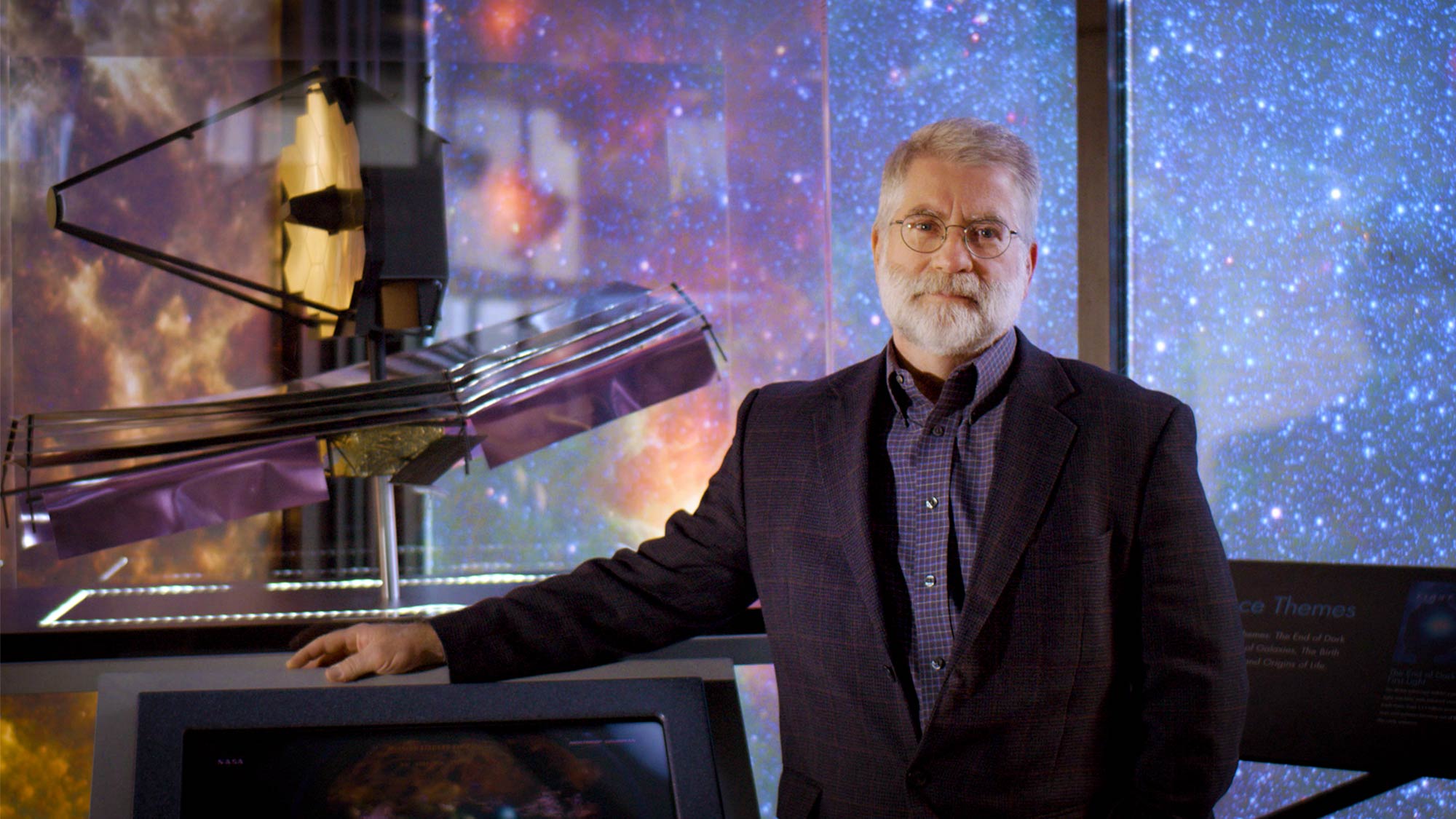
Michael Menzel of NASA’s Goddard Space Flight Center is the lead mission systems engineer for the Webb telescope — the chief engineer for the project.
Umit Gulsen for Quanta Magazine
Menzel, who is thickset with a neatly clipped gray beard, oversees thousands of people’s work on one of the most complicated engineering projects in history; he’s also the type of person who tells you right away where they’re from. That would be Elizabeth, New Jersey — Exit 13 off the turnpike — where his father drove a cab. On a recent Zoom call, Menzel bent his arm back and forth at the elbow to explain the challenge presented by the sunshield. “If you take something rigid, like a door, and you build a nice hinge, you can predict the way that moves,” he said. “That’s a piece of cake.” He stopped bending his arm. “Now you got blankets. They’re floppy. Try to push on a blanket on your bed and predict the shape that it’s going to go in. It’s horrible. Same thing with a string — the strings that tension [the sunshield]. There’s a million different ways that a string can move.” It gets worse: “Now put all this experience in zero-G, where that stuff can go in places you just don’t want it to go.” Smoothly unfolding the sunshield “becomes a very tough problem.”
Around 2004, the NASA engineers Chuck Perrygo and Keith Parrish came into Menzel’s office at Goddard and said they had a way to do it. Perrygo picked up a piece of paper on Menzel’s desk and folded it into the shape of a Z. The sunshield could be folded into many more such zigzags, in what’s sometimes called an accordion fold. “I’m pretty good at recognizing a bad answer, and I’m pretty good at recognizing a right answer,” Menzel told me, holding up a piece of paper he had folded into a Z shape. “So we all saw that and thought, that’s a way to pursue it.” Northrop Grumman was separately coming to the same conclusion.
The next question was how to hold the accordion fold in place until the sunshield was ready to unfurl. A Northrop Grumman engineer, Andy Tao, found the solution: 107 pins that retract like a cat’s claws.
The pin approach sprouted another tricky problem: pins make pinholes. If, after unfurling, pinholes on all five Kapton layers were to line up, this would let a sunbeam through, heating the optics. “It was one of those arcane little details that you’d never guess until you start getting into it and you start finding out, ah, Christ, five of the pinholes are lining right up and that’s going to let sunlight right in,” Menzel said. “It doesn’t sound like much, but it was driving Andy to drink. And God bless him, he figured it out.” Tao diligently sought out a suitable configuration of pins so that the holes in the five slightly-different-size Kapton layers would never align from any angle.
The moles were being whacked so slowly that astronomers began referring to the situation as “the JWST problem.” Back in 1996, Mather and his team estimated that the telescope would cost $564 million — a somewhat disingenuous guess aimed at getting Congress on board — and that it would launch in 2007. As the price tag soared and the launch date hopped ever farther into the future, Congress grew impatient. In 2011, JWST was nearly canceled, but elementary school students wrote letters to Washington and Senator Mikulski again came to NASA’s rescue.
Glass, metal and plastic gradually got bolted together in clean rooms at Goddard, Northrop Grumman, Ball Aerospace and elsewhere. But the assembled hardware couldn’t simply be sent skyward, because the telescope is going a million miles away, where astronauts with wrenches can’t visit. As Northrop Grumman engineer Jon Arenberg once put it, “This is a one-strike-and-you’re-out business.” Webb must deploy flawlessly on the first and only try. That means it had to be extensively, painstakingly tested on the ground. And in 2017 and 2018, these tests turned up one problem after another.
After a “shake test,” a bunch of screws and washers that had held the sunshield cover in place were found on the floor; they hadn’t been properly torqued. Another time, the sunshield caught on a snag and tore. Once, it unfolded, but not without a string wrapping around something it shouldn’t have.
The telescope got in another scrape when it was shipped to the Johnson Space Center in Houston, placed in the chamber where Apollo astronauts once practiced their moonwalks, and cryogenically cooled to simulate the conditions of outer space. While instrument builders like Sarah Kendrew were testing the cold hardware, Hurricane Harvey hit. The whole city catastrophically flooded, but the biggest worry for the Webb team was the liquid nitrogen supply. If it ran out, the telescope’s temperature would rise too quickly, damaging the instruments. The liquid nitrogen suppliers had to be urged to send trucks through the floodwaters as a matter of national importance.
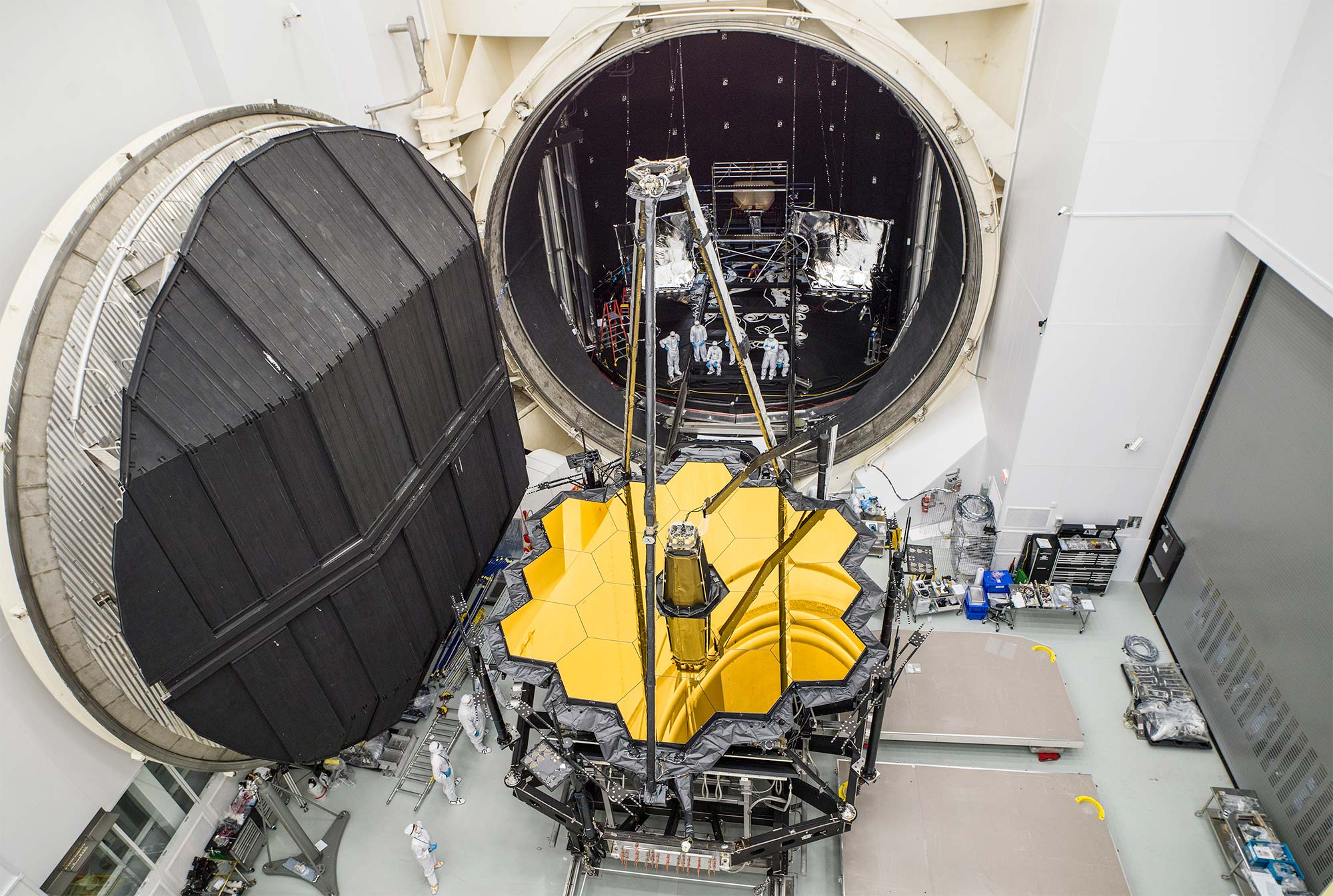
The Webb telescope emerged from a vacuum chamber at NASA’s Johnson Space Center in Houston on December 1, 2017, after about 100 days of cryogenic testing. Hurricane Harvey raged outside while the telescope experienced a cold, airless environment akin to that of space.
Chris Gunn/NASA
Problems continued. Earlier this year, the transponders that will blip data back to Earth were found to be faulty and had to be repaired. “A delay causes its own cascade of issues,” Tremblay said — and more expense: “It costs $10 million a month just to keep James Webb on the clean room floor.” As the investment rose, so did the need for the mission to succeed. “If NASA was willing to accept more risk, JWST would have been half the cost,” Tremblay explained.
Finally, problems abated. Northrop Grumman engineers successfully unfolded the sunshield several times at its facility in Redondo Beach, California. But according to Menzel, even after the shimmery layers have spread smoothly open, “we aren’t as elated as you might think. Because we all know that sunshield will only be as good as the last time it’s folded.”
Webb’s final cost approaches $10 billion. That’s nearly 20 times its sticker price, but still a few billion less than an aircraft carrier. Following some final pandemic-related delays, late 2021 became its target launch date. In September, the telescope passed a final test in Redondo Beach: Gold ears pinned back and blanket stashed away, the whole observatory was turned on its side, then righted, then checked to see whether anything had changed. Then it was put back on its side into a shipping container and taken away. Garth Illingworth, who has been involved with the telescope in a range of capacities since the beginning, went to Redondo Beach to see it off. There it had stood, “tall and majestic,” he wrote in an email. “By the next day the clean room was even empty of any JWST-related support hardware.” The exact date of the shipping container’s departure from California was kept quiet — a precaution against piracy on the high seas — but in early October it voyaged through the Panama Canal to French Guiana, a region near the equator where the European Space Agency launches its plus-size Ariane 5 rocket to exploit the extra kick of Earth’s rotation.
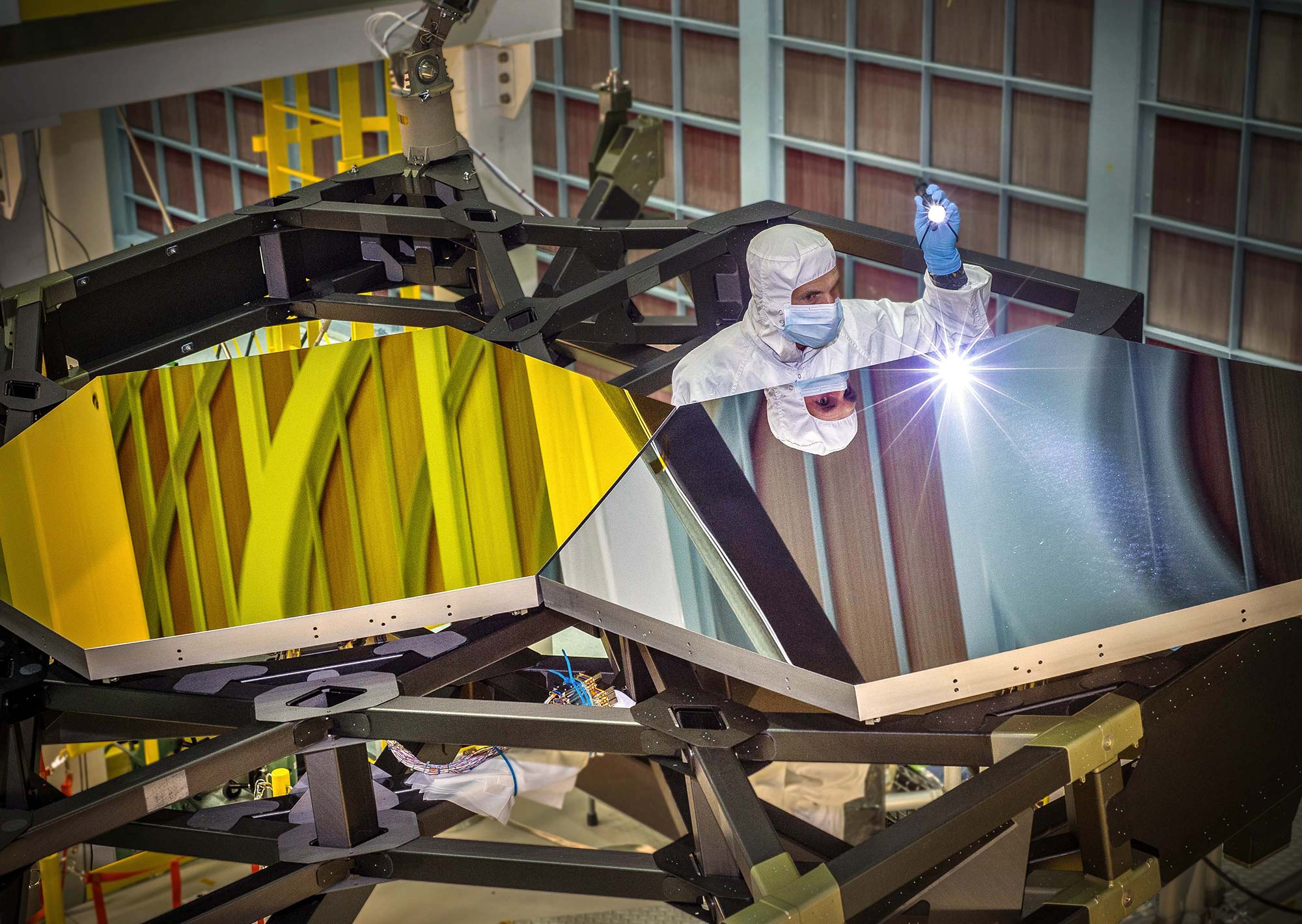
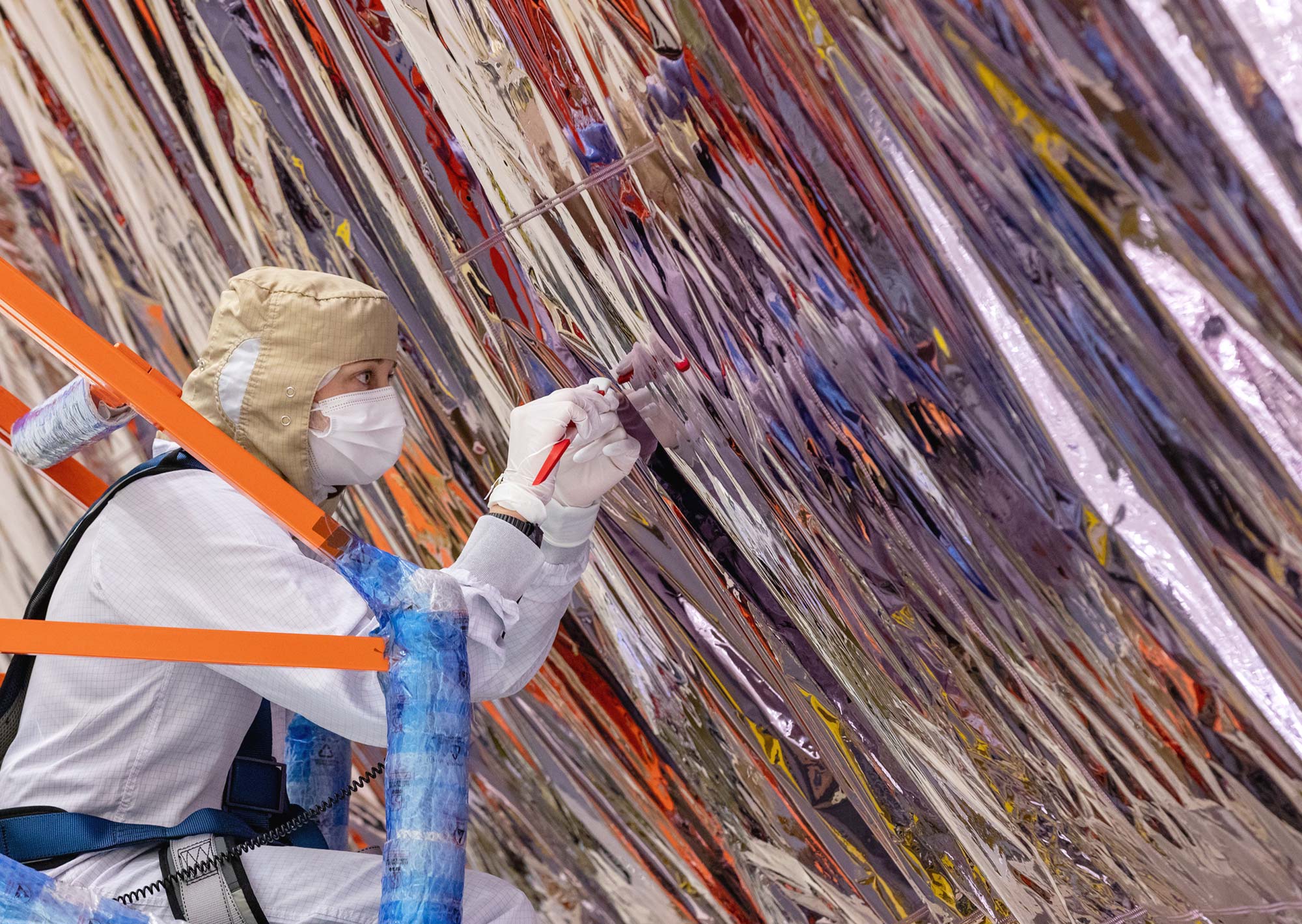
An engineer examines test mirror segments in the clean room of NASA’s Goddard Space Flight Center in Maryland; a technician helps to pack up the sunshield for the final time in February 2021.
Northrop Grumman
An engineer examines test mirror segments in the clean room of NASA’s Goddard Space Flight Center in Maryland; a technician helps to pack up the sunshield for the final time in February 2021.
Northrop Grumman
The Webb team is busy rehearsing the routines they’ll execute 24/7 out of Baltimore during Webb’s monthlong journey to Lagrange point 2, followed by its five-month commissioning period. “Do I feel confident?” said Menzel. “Yes. I feel confident that we’ve done everything we possibly could. The risk is acceptably low. It’s as good as it’s going to be. And I’m pretty confident that we’re going to do fine.
“Could something go wrong? Hell, yeah.”
Reasonable Guesses
Once the Hubble got working, humanity soaked up the sight of the cosmos like near-sighted kids wearing glasses for the first time. We also learned there was stuff out there that we couldn’t see.
In 1998, two rival teams of astronomers used the Hubble along with other telescopes to observe supernovas in distant galaxies and ascertain that the expansion of the universe is accelerating. This exposed the existence of an accelerating agent infusing all of space, known as dark energy. There’s so much space that dark energy makes up 70% of everything. (Another 26% is dark matter, and 4% is luminous atoms and radiation.)
Other puzzles soon turned up. The astronomer Wendy Freedman used Hubble to observe pulsating stars called cepheids. From these, in 2001 she and her team measured how fast the universe is currently expanding, achieving 10% accuracy, a huge improvement over previous measurements. In the years since Freedman’s measurement, the cosmic expansion rate has landed at the center of the biggest controversy in cosmology. The issue is that, based on the universe’s known ingredients and governing equations, theorists infer that space should currently be expanding more slowly than the measurements suggest. Its fast expansion may point to additional unknown ingredients in the cosmos beyond dark matter and dark energy. But Freedman, who is calm and authoritative, isn’t convinced yet that the measurements are right. She’ll lead a team that will use the Webb telescope to scrutinize cepheids and other stars more closely; they hope to measure the expansion rate precisely enough to tell for sure whether there’s an exotic fundamental ingredient afoot.
Meanwhile, the Hubble Deep Field photo told a rollicking story of galaxy evolution that dramatically expanded human knowledge of cosmic history. But it remains to Webb to read the crucial first couple of chapters of the story.
Marcia Rieke, a longtime professor at the University of Arizona regarded as one of the pioneers of infrared astronomy, has spent the last 20 years overseeing the design and construction of NIRCam (as in “near-infrared camera”), one of Webb’s four main instruments. She and her team at Arizona are planning to use more than half of their whopping 900 hours of guaranteed telescope time to do a new deep-field survey, one that will peer deeper into the past than ever before. Whereas Hubble could see the faint smudges of galaxies at redshift 10, corresponding to 500 million years after the Big Bang, Webb should be able to see those smudges very clearly and spot brand-new galaxies germinating farther away, perhaps as far back as 50 or 100 million years after the Big Bang.
Rieke and her team will do one better than the Hubble deep field. After using NIRCam to get an image of their dark patch of the sky, they’ll identify the galaxies in the patch that are farthest away and use NIRSpec, Webb’s near-infrared spectrograph, to take the galaxies’ spectra, from which Rieke and her colleagues can deduce their chemical compositions.
The spectrum will show which elements of the periodic table existed in each proto-galaxy, and how their elements evolved over time. The standard story is that early gas clouds, stars and galaxies mostly consisted of hydrogen, and supernovas and other explosive events gradually forged heavier elements. “But there are curious things,” Rieke said. “Close to the limit that Hubble can go to, there are quasars” — super-bright centers of galaxies powered by supermassive black holes — “and it looks like they have almost the same elements as the sun. Which is hard to believe. So there’s something that goes on early that we don’t have a good handle on.”
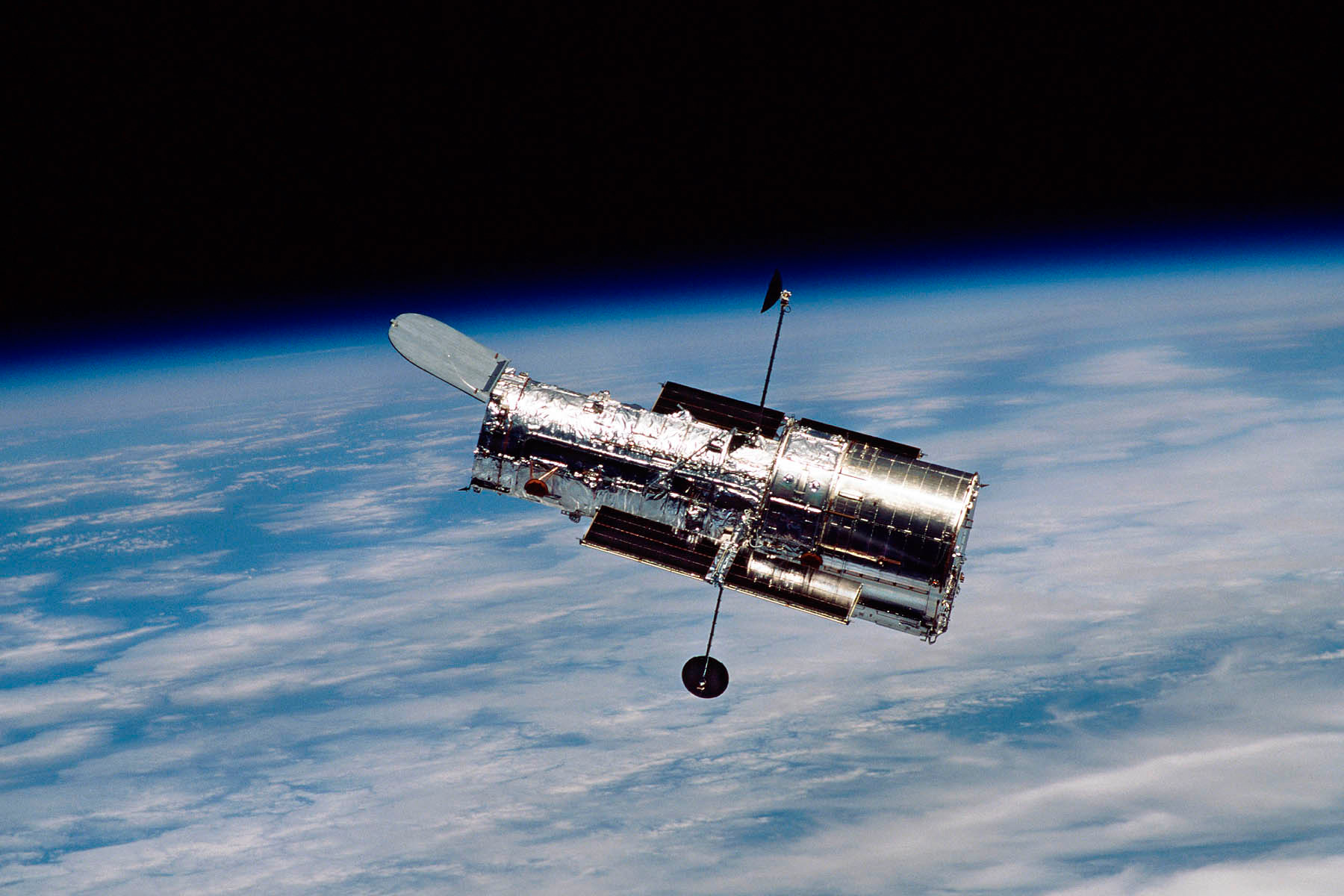
The Hubble Space Telescope is in low-Earth orbit, close enough for a Space Shuttle visit. This photo was taken after Hubble’s fourth servicing mission in 2002. The fifth and final mission took place in 2009.
NASA
There are as many reasons for wanting to see the first stars and galaxies as there are astronomers, astrophysicists and cosmologists. For Risa Wechsler, a cosmologist at Stanford University, it’s a way to watch dark matter’s handiwork. She and her colleagues will use the proto-galaxies to deduce the distribution of sizes of dark matter halos that must have existed in the early universe, and when they formed. This can reveal whether dark matter is “cold,” that is, made of slow-moving particles, or “warm,” since particles that whizz around would have taken longer to huddle into halos. This temperature check would be a significant clue to dark matter’s nature.
Other researchers want to understand the first stars. Some think Webb will see so-called “Population III stars,” primordial beasts that are hypothesized to have been roughly 10,000 times heavier than our sun. Such stars would help solve another major mystery of galaxy formation: how galaxies’ centers ended up with supermassive black holes — physically small yet incredibly powerful gravitational sinkholes that can weigh billions of times the mass of our sun. Nobody knows how supermassive black holes grew so heavy, or when, or why their properties are correlated with properties of their host galaxies. One theory is that Population III stars seeded the holes, but there are a million other theories. Webb will look for signatures of the different scenarios.
Theorists have simulated many possibilities for how structures might have emerged in the young universe. But they can’t simply start with the cosmic microwave background and evolve that picture forward on the computer to see what happened. “A lot of the initial conditions are not well understood — things like the magnetic field, and how much turbulence there is in the gas,” said Peter Behroozi, a theorist colleague of Rieke’s at Arizona who simulates star and galaxy formation. It’s “a lot of work,” he said, to get from a large, ever-so-slightly dense spot in the cosmic microwave background to a tiny cloud of gas that will gravitationally contract and make a star.
“Oftentimes what people will do is, they’ll just skip that,” Behroozi said, and “start with a spherical cloud of gas. They don’t know what the distribution of [dark matter] clump sizes will be, so they guess. They don’t know about the magnetic field; they don’t know anything about the spin or turbulence of the gas, so they’ll fill all that in with guesses.”
The guesswork has accelerated recently as researchers race to get their predictions on record before Webb shows how star and galaxy formation really went down. Even conservative guesses can produce simulations with wildly different outcomes. “The main conclusion from my research,” Behroozi said, “is even if you try to make a reasonable guess, we still have no clue what James Webb will see.”
Bridge Planets
Natasha Batalha, Natalie Batalha’s second child, was 18 when she went to Florida for the Kepler launch. She remembers tagging along with her younger sister in the viewing room where the NASA science team had gathered. “During the launch, the anxiety that was in that space was chilling,” she said on a recent video call. After liftoff, the scene turned jubilant. She found it inspiring to see a team accomplish something so grand, but it was the possibility of discoveries being so close at hand “that was really what flipped on my brain to start thinking about exoplanets as a concept,” said Natasha Batalha, who is serious and precise, like her mother.
Space wasn’t a constant topic of discussion in the Batalha household. “I didn’t want to saturate their lives with science,” Natalie Batalha said. “I always wanted them to feel like they were number one.” But she and Celso did have “a secret hope” about Natasha. One evening in 1996 while Celso was teaching a night class, Natalie loaded up the half-asleep kids to drive them to a meadow so they look for the passing comet Hyakutake. Before they’d pulled out of the driveway, five-year-old Natasha said from the back seat: “What’s that?” She was pointing at the comet.
When Natasha was eight and living in Brazil, her mother asked her and her siblings to draw an astronomer. Natasha drew a white man, and Natalie asked her why. “This was crazy for me, the daughter of a Latinx scientist and a female scientist; I still had these stereotypes ingrained in my mind,” Natasha said. She suddenly felt empowered by the thought that she could belong in science.
A couple of years later she read Sally Ride’s autobiography. Just as her mother had been inspired by Ride, Natasha decided to become either an astronomer or an astronaut. She dreamed of being the first person on Mars. After the Kepler launch, as more and more exoplanets were discovered, she grew interested in the possibility of extraterrestrial life and how we might infer its presence on those planets through telescope observations of their skies. She got a dual Ph.D. in astronomy and astrobiology. Then, soon after Kepler ended and her mom left NASA Ames to become a professor at Santa Cruz, Natasha took a job at Ames studying exoplanet atmospheres.
Natasha Batalha is part of a growing research community whose ultimate goal is to detect “biosignature gases” — gases in a planet’s atmosphere that could only be there because of life. Every kind of molecule has characteristic wavelengths that it absorbs. So by collecting light from a star when a planet is and isn’t transiting in front of it, and checking which wavelengths of starlight grow dimmer when the planet is there, you can see which molecules are present in the planet’s sky.
Oxygen is an obvious candidate for a biosignature gas: It’s so reactive that it’s unlikely to be found unless the planet’s oxygen supply is continually replenished by, say, a biosphere doing photosynthesis. Photosynthesis is such a simple and efficient energy-capturing procedure that astrobiologists think it’s likely to evolve on any living planet, so oxygen is smart to look for.
Samuel Velasco/Quanta Magazine; Source: NASA
But seeing oxygen by itself wouldn’t necessarily be convincing. Computer simulations show that under some conditions, oxygen can fill the skies of lifeless planets. “The challenge is there’s not one gas that’s going to be a biosignature gas,” said Hammel, the planetary scientist. “Methane on Earth is mostly produced by cows … but you look at Neptune, and you can see tons of methane there, and that’s not produced by cows.”
A better biosignature is a peculiar mix of gases. “It’s not going to be a single gas, it’s going to have to be a combination of gases in a configuration that tells us they are in a disequilibrium state,” said Hammel. “They can’t have formed that way naturally.”
Existing telescopes have already spotted molecular fingerprints in the skies of hot Jupiters, but these are lifeless planets. Detecting the weaker signals from rocky, possibly habitable planets’ skies will require JWST. Not only will the telescope have close to 100 times Hubble’s resolution, but it will see exoplanets far more clearly against the background of their host stars, since planets emit more infrared than optical light, while stars emit less. Importantly, Webb’s view of exoplanets won’t be obscured by clouds, which often prevent optical telescopes from seeing the densest, low-altitude layers of atmosphere. “Imagine being in a plane and looking down at an insane cloud deck, and you can’t see the surface at all,” Natasha Batalha said. “When you look at infrared light, you can all of a sudden see through the cloud deck.”
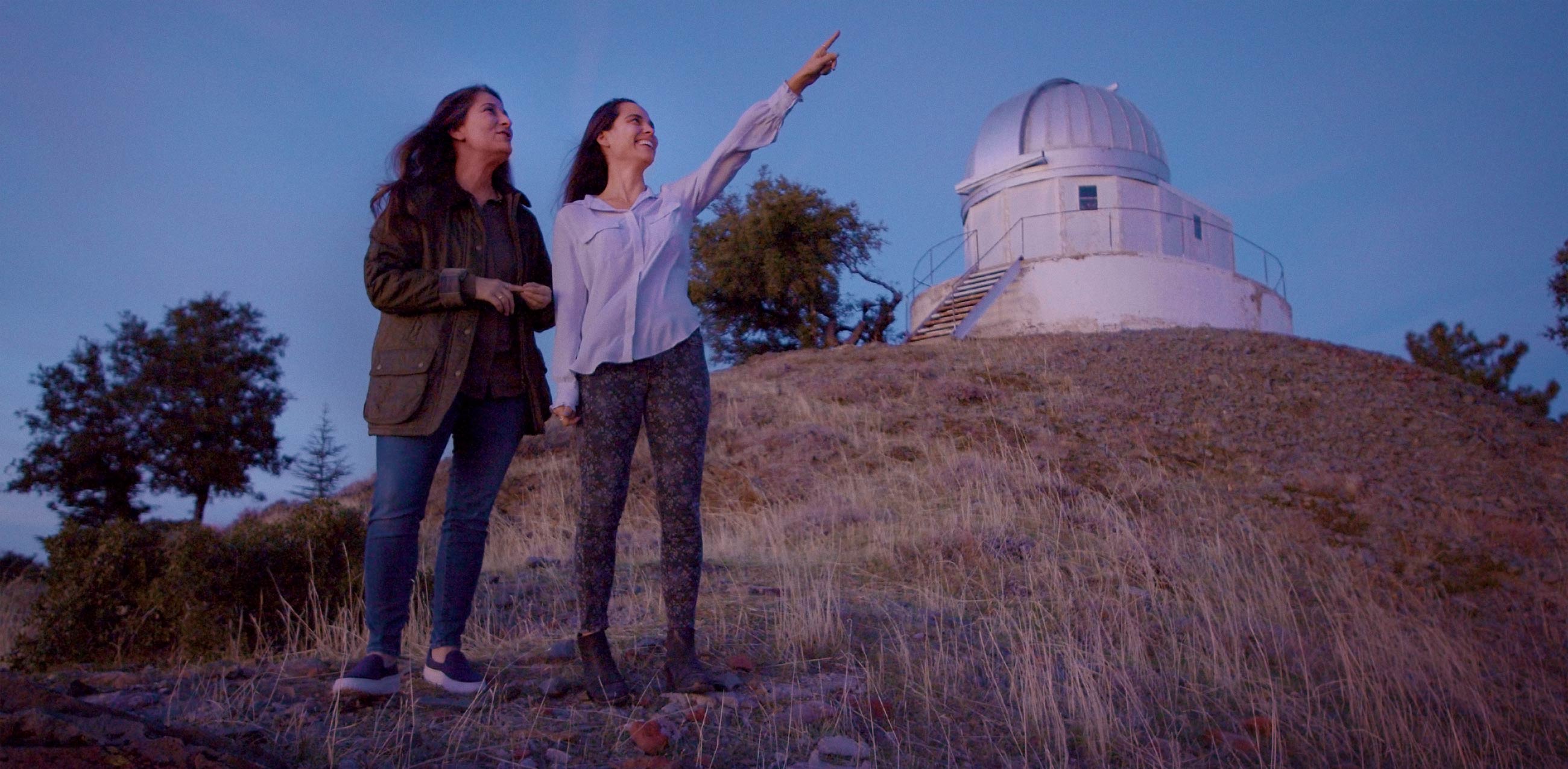
Marcos Rocha for Quanta Magazine
Exoplanets will be among the targets in JWST’s “Cycle 1” round of observations, which it will start tackling as soon as deployment and commissioning are complete — about six months after launch. The exoplanet community elected Natalie Batalha to lead transit spectroscopy studies of three gas giants as part of these early observations. Her team will also develop data pipelines and processing techniques for the community to copy.
Cycle 1 also includes observations for specific groups of astronomers. Last year, more than 2,000 groups submitted proposals to use JWST in the first cycle; a time allocation committee selected 266. Dozens of these programs will look at planets. When I video-chatted with Hammel, she screen-shared PowerPoint slides highlighting various exo-worlds of interest that Webb will turn its eye toward on behalf of different observers: Kepler 16b, which orbits two stars; the suspected “lava world” 55 Cancri e; and the seven rocky planets of the nearby Trappist-1 star system. (Hammel, who gets 100 hours of guaranteed observer time as a longtime member of the Webb science team, will browse our own solar system, including Jupiter’s red spot, the mysterious, far-flung objects of the Kuiper belt, and Hammel’s oft-overlooked favorites, Uranus and Neptune, which appeared as a pair of plush toys behind her on her office couch.)
Out of all the exoplanets that JWST will look at in Cycle 1, Natasha Batalha reckons that the three Trappist planets that orbit in their star’s habitable zone probably have the best shot at featuring detectable biosignature gases. “The Trappist system is unique in that the star is very small, and so the relative feature size of the atmospheres doesn’t need to be big in order for you to be able to see it,” she said. Whether Webb has a realistic chance of spotting biosignature gases is debatable, however. “Often the controversy comes up over the detection of oxygen,” she said. Oxygen absorbs one infrared wavelength in Webb’s range of sensitivity, and so theoretically an oxygen-rich transiting planet could put a noticeable dip in its star’s spectrum at that wavelength. “However,” she said, the wavelength “is just at the edge where the detector loses sensitivity.” Other types and combinations of gases will be easier to detect but might be harder to definitively attribute to life.
Webb might just identify possibly living planets, which would then be examined more closely with future space telescopes. Astronomers are busy planning those now. NASA’s Nancy Grace Roman Space Telescope, slated to launch later this decade, is mostly designed to study dark energy; Earth-like exoplanets are the purview of a future telescope concept provisionally known as LuvEx, an ultraviolet, optical and IR telescope that (if funded by Congress) will launch in the mid-2040s.
What we will look at then depends on what we learn in the next few years.
One morning this spring, Natasha Batalha woke up to a text from fellow exoplanet astronomer Johanna Teske: “We got it!” The 266 selected Cycle 1 programs had just been announced, and a proposal led by Batalha, with Teske as her deputy, made the list.
Theirs will be the most extensive of all the exoplanet observing campaigns in the first cycle: a 142-hour survey of super-Earths and sub-Neptunes, the ubiquitous midsize “bridge” planets that our solar system lacks, and whose composition, habitability and formation history are unknown. Assuming that, over the next few months, everything unfolds as it should and the James Webb Space Telescope finds its focus, it will point at 11 of these planets on behalf of Natasha Batalha and her team. When she awoke to the good news, first she called Teske. Then she called her mom.
Corrections: June 3, 2022
The original version of this article featured an image of the M100 galaxy that was incorrectly identified as having been taken by the Hubble Space Telescope. That image has been replaced with the correct Hubble image. In addition, the original article also incorrectly stated that Hubble does not have a spectrograph. Hubble now has two spectrographs; both were added to the telescope after the Hubble Deep Field image was taken.
